Compare Flodesk, Klaviyo, and Maestra across 16 marketing criteria—omnichannel flows, email, SMS, loyalty, pricing, and more—to find the best fit for your growth in 2025.
Flodesk vs Klaviyo vs Maestra: Choosing the Right Marketing Platform
Flodesk and Klaviyo excel in different areas for e-commerce marketers. Here’s how they cater to specific business needs and use cases:
Flodesk made a name for itself by helping users send beautiful emails without the complexity of enterprise platforms. Its strength lies in intuitive design and simplicity—perfect if all you need is basic email marketing.
However, Flodesk’s functionality is limited. It lacks advanced automation, multi-channel outreach, or robust customer data management. In practice, this means you’ll eventually need to bolt on other tools as your marketing needs grow.
If you’re just starting out and want an affordable, straightforward way to send gorgeous emails, Flodesk fits the bill. But for anything beyond the basics, you’ll quickly run up against its limits.
Best for: Small businesses and solo entrepreneurs looking for a simple, design-focused email tool with flat pricing.
Klaviyo has become the go-to for data-driven email marketing in e-commerce.
It offers rich segmentation, automation workflows, and built-in SMS. Klaviyo integrates natively with Shopify and other platforms, pulling in purchase and browsing data to personalize campaigns. Its flow builder lets marketing teams set up abandoned cart reminders, post-purchase follow-ups, and more.
However, Klaviyo stops short of a full unified experience. It doesn’t natively include on-site personalization, loyalty programs, or other engagement channels beyond email/SMS. You can achieve a holistic strategy with Klaviyo, but it often requires third-party apps (for reviews, referrals, etc.) and a bigger budget as your contact list grows.
In short, Klaviyo is a robust step up for multi-channel email marketing, but not an all-in-one solution.
Best for: Growing e-commerce brands seeking powerful email & SMS marketing with deep e-commerce integration.
Neither Attentive nor Klaviyo include a true built-in customer data platform or native loyalty features, so personalized omnichannel marketing can be challenging on those tools. They also tend to offer one-on-one strategic support only to their largest customers—smaller teams must rely on standard support or self-serve resources.
These limitations often lead to a fragmented marketing stack (and higher total costs) once you need capabilities beyond the basics.
That’s why we included Maestra in this comparison. It’s the most unified platform of the three, designed to eliminate those gaps
Maestra is the most unified platform of the three, designed to be the central “brain” of your marketing.
It combines a real-time customer data platform (CDP) with orchestrated marketing across email, SMS, websites, mobile apps, in-store, and even paid ads. Instead of juggling disparate tools, Maestra lets you build hyper-personalized flows that respond to customer behavior in real time on every channel.
Key features include advanced segmentation, real-time site personalization, product recommendations, loyalty programs, and more. Crucially, all these features are native to Maestra, so your data and messaging stay in sync without heavy lifting.
With white-glove support and a dedicated success manager, Maestra caters to teams who want enterprise-grade capabilities without needing a roster of point solutions.
If you’re aiming to elevate your marketing with a one-stop platform that handles everything from emails to on-site experiences, Maestra stands out as a compelling choice.
Best for: Mid-market brands with established marketing teams that need a unified platform to personalize campaigns across all channels.
In this in-depth comparison, we’ll evaluate Flodesk vs Klaviyo vs Maestra on all the key areas e-commerce marketers care about.
Content:
Comparison Summary: Flodesk vs Klaviyo vs Maestra
Feature
Flodesk
Klaviyo
Maestra
Omnichannel Flows
⭐⭐
Basic email workflows only. No multi-channel flow builder or built-in CDP, making unified campaigns difficult.
Basic email workflows only. No multi-channel flow builder or built-in CDP, making unified campaigns difficult.
⭐⭐⭐⭐
Email and SMS automation with e-commerce triggers. Lacks native support for web/app channels and requires integrations for a truly cohesive experience.
Email and SMS automation with e-commerce triggers. Lacks native support for web/app channels and requires integrations for a truly cohesive experience.
🏆
⭐⭐⭐⭐⭐
Fully omnichannel: connect email, SMS, web, mobile app, in-store, and ads in unified flows. Real-time CDP ensures all channels react to customer behavior for seamless journeys.
⭐⭐⭐⭐⭐
Fully omnichannel: connect email, SMS, web, mobile app, in-store, and ads in unified flows. Real-time CDP ensures all channels react to customer behavior for seamless journeys.
Customer Data Management & Segmentation
⭐⭐
Stores basic subscriber info and segments by sign-up or tags. No robust customer data platform; limited targeting beyond simple lists.
Stores basic subscriber info and segments by sign-up or tags. No robust customer data platform; limited targeting beyond simple lists.
⭐⭐⭐⭐
Strong segmentation based on purchase and engagement data. Predictive analytics (e.g. CLV) available. Not a full CDP, but integrates e-commerce data well for marketing segments.
Strong segmentation based on purchase and engagement data. Predictive analytics (e.g. CLV) available. Not a full CDP, but integrates e-commerce data well for marketing segments.
🏆
⭐⭐⭐⭐⭐
Real-time CDP unifying online and offline data. Advanced, AI-powered segmentation (RFM, product-based, nested segments) for precise targeting at any scale. Updates segments instantly as behaviors happen.
⭐⭐⭐⭐⭐
Real-time CDP unifying online and offline data. Advanced, AI-powered segmentation (RFM, product-based, nested segments) for precise targeting at any scale. Updates segments instantly as behaviors happen.
Site Personalization
⭐
No native web personalization features beyond simple email opt-in forms. Cannot customize on-site content per visitor (requires external tools).
No native web personalization features beyond simple email opt-in forms. Cannot customize on-site content per visitor (requires external tools).
⭐⭐
Offers pop-ups and signup forms for lead capture, but little in-session personalization. No native ability to change site content based on behavior without coding or third-party apps.
Offers pop-ups and signup forms for lead capture, but little in-session personalization. No native ability to change site content based on behavior without coding or third-party apps.
🏆
⭐⭐⭐⭐⭐
In-session personalization engine. Can dynamically alter site content (banners, pop-ups, product displays, etc.) based on each visitor’s behavior, location, or segment—all in real time. Full control to tailor every on-site experience without coding.
⭐⭐⭐⭐⭐
In-session personalization engine. Can dynamically alter site content (banners, pop-ups, product displays, etc.) based on each visitor’s behavior, location, or segment—all in real time. Full control to tailor every on-site experience without coding.
Email
⭐⭐⭐
User-friendly email builder with beautiful templates. Supports basic automations (welcome sequences, newsletters) but lacks advanced triggers, testing, or dynamic content.
User-friendly email builder with beautiful templates. Supports basic automations (welcome sequences, newsletters) but lacks advanced triggers, testing, or dynamic content.
⭐⭐⭐⭐
Comprehensive email marketing suite. Drag-and-drop editor, advanced flows, A/B testing, and deliverability tools. Integrates product data for personalized recommendations. A top choice for e-commerce email, though some personalization requires workarounds.
Comprehensive email marketing suite. Drag-and-drop editor, advanced flows, A/B testing, and deliverability tools. Integrates product data for personalized recommendations. A top choice for e-commerce email, though some personalization requires workarounds.
🏆
⭐⭐⭐⭐⭐
Proprietary email composer focused on deliverability and personalization. Dynamic blocks auto-populate content per segment (even language preferences). Granular control (UTM tracking, AMP email, send-time optimization) with clean code to avoid spam/clipping. Enterprise-grade email capabilities at scale (500k+ emails/hour).
⭐⭐⭐⭐⭐
Proprietary email composer focused on deliverability and personalization. Dynamic blocks auto-populate content per segment (even language preferences). Granular control (UTM tracking, AMP email, send-time optimization) with clean code to avoid spam/clipping. Enterprise-grade email capabilities at scale (500k+ emails/hour).
SMS
⭐
No built-in SMS marketing. Would need a separate SMS service or integration; cannot send or automate texts natively.
No built-in SMS marketing. Would need a separate SMS service or integration; cannot send or automate texts natively.
⭐⭐⭐⭐
Fully integrated SMS alongside email. Supports automation (e.g. cart abandonment texts, promos) and segmentation. Lacks advanced features like cross-channel orchestration, but solid for text marketing.
Fully integrated SMS alongside email. Supports automation (e.g. cart abandonment texts, promos) and segmentation. Lacks advanced features like cross-channel orchestration, but solid for text marketing.
🏆
⭐⭐⭐⭐⭐
Native part of omnichannel flows—SMS works in tandem with email, push, etc. Supports bulk campaigns with high-speed sending, cross-device customer matching, A/B testing of messages, link tracking, and automatic shortening. All SMS engagement feeds back into the CDP for real-time flow triggers.
⭐⭐⭐⭐⭐
Native part of omnichannel flows—SMS works in tandem with email, push, etc. Supports bulk campaigns with high-speed sending, cross-device customer matching, A/B testing of messages, link tracking, and automatic shortening. All SMS engagement feeds back into the CDP for real-time flow triggers.
Website & Email Product Recommendations
⭐
No product recommendation engine. You can manually feature products in emails, but no AI-driven suggestions or on-site recommendation widgets.
No product recommendation engine. You can manually feature products in emails, but no AI-driven suggestions or on-site recommendation widgets.
⭐⭐⭐
Offers AI-driven product recommendations in emails (via dynamic product blocks). Can pull “customers also bought” or best-sellers into campaigns. However, no native on-site recommender (requires apps like Wiser), so cross-channel personalization is limited.
Offers AI-driven product recommendations in emails (via dynamic product blocks). Can pull “customers also bought” or best-sellers into campaigns. However, no native on-site recommender (requires apps like Wiser), so cross-channel personalization is limited.
🏆
⭐⭐⭐⭐⭐
Built-in AI recommendations across email and web. Predictive algorithms suggest products based on each customer’s behavior and attributes in real time. Supports cross-sell, upsell rules, and manual tuning. Essentially provides Amazon-like recommendation capabilities for your store, synced across site and emails.
⭐⭐⭐⭐⭐
Built-in AI recommendations across email and web. Predictive algorithms suggest products based on each customer’s behavior and attributes in real time. Supports cross-sell, upsell rules, and manual tuning. Essentially provides Amazon-like recommendation capabilities for your store, synced across site and emails.
Promotions and Referrals
⭐
No native referral program or advanced promo engine. Marketers must create one-off coupon codes in their e-commerce platform and email them manually. No tracking of referrals or complex promo logic out of the box.
No native referral program or advanced promo engine. Marketers must create one-off coupon codes in their e-commerce platform and email them manually. No tracking of referrals or complex promo logic out of the box.
⭐⭐
No built-in loyalty/referral module (often integrated via apps). Can send unique coupon codes to customers through emails and SMS (e.g. Shopify discount integration), enabling promotions like one-time discounts. However, running a structured referral program or conditional promotions requires external tools.
No built-in loyalty/referral module (often integrated via apps). Can send unique coupon codes to customers through emails and SMS (e.g. Shopify discount integration), enabling promotions like one-time discounts. However, running a structured referral program or conditional promotions requires external tools.
🏆
⭐⭐⭐⭐⭐
Robust promotion engine with referrals and rule-based offers. You can set up refer-a-friend campaigns alongside targeted promotions triggered by time, location, behavior, or segment. Stack or sequence promotions (e.g. tiered discounts, limited-time offers) and sync them across email, SMS, and on-site banners automatically. Referral rewards and promo codes are managed within Maestra, feeding loyalty points or incentives in real time.
⭐⭐⭐⭐⭐
Robust promotion engine with referrals and rule-based offers. You can set up refer-a-friend campaigns alongside targeted promotions triggered by time, location, behavior, or segment. Stack or sequence promotions (e.g. tiered discounts, limited-time offers) and sync them across email, SMS, and on-site banners automatically. Referral rewards and promo codes are managed within Maestra, feeding loyalty points or incentives in real time.
Loyalty Programs
⭐
No loyalty program features. Cannot track points, tiers, or rewards without a separate loyalty app. Flodesk emails can deliver coupons, but the platform won’t manage any loyalty scheme.
No loyalty program features. Cannot track points, tiers, or rewards without a separate loyalty app. Flodesk emails can deliver coupons, but the platform won’t manage any loyalty scheme.
⭐
No native loyalty program. Requires integrating a dedicated loyalty solution (like Smile.io or LoyaltyLion) to handle points and VIP tiers. Klaviyo can segment VIPs or reward status if fed the data, but it doesn’t run the loyalty program itself.
No native loyalty program. Requires integrating a dedicated loyalty solution (like Smile.io or LoyaltyLion) to handle points and VIP tiers. Klaviyo can segment VIPs or reward status if fed the data, but it doesn’t run the loyalty program itself.
🏆
⭐⭐⭐⭐⭐
Full-fledged loyalty program module. Supports points, VIP tiers, and rewards natively. Highly flexible—you can reward not just purchases but any activity (reviews, referrals, site actions), and use Maestra’s omnichannel reach to promote and adjust loyalty offers in real time. Loyalty data (points, status) is part of the unified profile, so it triggers personalized messages across all channels (e.g. “double points for you” promos or VIP exclusives).
⭐⭐⭐⭐⭐
Full-fledged loyalty program module. Supports points, VIP tiers, and rewards natively. Highly flexible—you can reward not just purchases but any activity (reviews, referrals, site actions), and use Maestra’s omnichannel reach to promote and adjust loyalty offers in real time. Loyalty data (points, status) is part of the unified profile, so it triggers personalized messages across all channels (e.g. “double points for you” promos or VIP exclusives).
Mobile & Web Push Notifications
⭐
No push notification capability. Flodesk cannot send push messages; you’d need to use another tool if you want to re-engage via browser or mobile app notifications.
No push notification capability. Flodesk cannot send push messages; you’d need to use another tool if you want to re-engage via browser or mobile app notifications.
⭐⭐⭐⭐
Built-in mobile push for app users, integrating with flows. Lets you send push notifications to your iOS/Android app audience as part of campaigns. However, Klaviyo does not support web browser push natively (except via custom API workarounds). So web push requires another service.
Built-in mobile push for app users, integrating with flows. Lets you send push notifications to your iOS/Android app audience as part of campaigns. However, Klaviyo does not support web browser push natively (except via custom API workarounds). So web push requires another service.
🏆
⭐⭐⭐⭐⭐
Offers both web and mobile push out of the box. Marketers can craft rich push notifications (with images, buttons, deep links) to engage users on browsers and in apps. Push is seamlessly integrated into Maestra’s omnichannel flows—e.g. an on-site action can trigger a follow-up push, or an email click can suppress a redundant push. Advanced scheduling, A/B testing, and real-time tracking ensure push campaigns hit the right notes.
⭐⭐⭐⭐⭐
Offers both web and mobile push out of the box. Marketers can craft rich push notifications (with images, buttons, deep links) to engage users on browsers and in apps. Push is seamlessly integrated into Maestra’s omnichannel flows—e.g. an on-site action can trigger a follow-up push, or an email click can suppress a redundant push. Advanced scheduling, A/B testing, and real-time tracking ensure push campaigns hit the right notes.
Ad Optimization
⭐
No direct advertising integration. Flodesk cannot sync audiences to Facebook/Google or optimize paid ads; you’d export your email list manually to use it in ad platforms.
No direct advertising integration. Flodesk cannot sync audiences to Facebook/Google or optimize paid ads; you’d export your email list manually to use it in ad platforms.
⭐⭐⭐⭐
Integrates with major ad platforms to enhance targeting. Klaviyo can automatically sync segments to Facebook and Google Ads for retargeting and lookalike audiences. This means your email lists and customer segments stay up-to-date in your ad accounts, improving ad relevance. It doesn’t manage ad creative or bidding, but by ensuring ads use the latest customer data, Klaviyo helps improve ROI on your ad spend.
Integrates with major ad platforms to enhance targeting. Klaviyo can automatically sync segments to Facebook and Google Ads for retargeting and lookalike audiences. This means your email lists and customer segments stay up-to-date in your ad accounts, improving ad relevance. It doesn’t manage ad creative or bidding, but by ensuring ads use the latest customer data, Klaviyo helps improve ROI on your ad spend.
🏆
⭐⭐⭐⭐⭐
Holistic ad optimization as part of the platform. Maestra not only syncs segments to ad networks, it uses its real-time data to fuel smarter campaigns. For example, it can automatically create an audience of high-LTV shoppers who haven’t bought in 60 days and push it to Facebook for win-back ads, or pause ads to customers who just purchased. Maestra’s AI segments and triggers reduce wasted spend by refining who sees which ads and when—effectively bridging your owned and paid media efforts.
⭐⭐⭐⭐⭐
Holistic ad optimization as part of the platform. Maestra not only syncs segments to ad networks, it uses its real-time data to fuel smarter campaigns. For example, it can automatically create an audience of high-LTV shoppers who haven’t bought in 60 days and push it to Facebook for win-back ads, or pause ads to customers who just purchased. Maestra’s AI segments and triggers reduce wasted spend by refining who sees which ads and when—effectively bridging your owned and paid media efforts.
Reporting & Attribution
⭐⭐
Basic email stats only. Flodesk provides open rates, click rates, and subscriber growth metrics. There’s no multi-channel attribution or advanced analytics—you get the essentials to see how emails perform, but not much insight beyond that.
Basic email stats only. Flodesk provides open rates, click rates, and subscriber growth metrics. There’s no multi-channel attribution or advanced analytics—you get the essentials to see how emails perform, but not much insight beyond that.
⭐⭐⭐⭐
Robust campaign and flow analytics. Klaviyo shows revenue attribution for emails and SMS (e.g. how much $$ a welcome series generated), engagement over time, and even predictive CLV for customers. You can compare segments, track signup form conversions, and benchmark against industry metrics. It’s strong for email/SMS reporting, though it doesn’t natively do cross-channel attribution modeling. Still, marketing teams get a clear view of which campaigns drive sales and can export data for deeper analysis.
Robust campaign and flow analytics. Klaviyo shows revenue attribution for emails and SMS (e.g. how much $$ a welcome series generated), engagement over time, and even predictive CLV for customers. You can compare segments, track signup form conversions, and benchmark against industry metrics. It’s strong for email/SMS reporting, though it doesn’t natively do cross-channel attribution modeling. Still, marketing teams get a clear view of which campaigns drive sales and can export data for deeper analysis.
🏆
⭐⭐⭐⭐⭐
Advanced reporting with multi-channel attribution. Maestra offers dashboards to track not just individual campaign metrics, but how each channel and flow contributes to your bottom line. You can set up control groups to measure true lift of campaigns and run A/B tests across channels (e.g. email vs. SMS impact). Attribution is customizable—see first-touch, last-touch, or even weighted attribution for conversions. Plus, all data can be exported or piped into BI tools as needed. In short, Maestra gives marketing teams the full picture of customer engagement and ROI across channels, not just siloed email stats.
⭐⭐⭐⭐⭐
Advanced reporting with multi-channel attribution. Maestra offers dashboards to track not just individual campaign metrics, but how each channel and flow contributes to your bottom line. You can set up control groups to measure true lift of campaigns and run A/B tests across channels (e.g. email vs. SMS impact). Attribution is customizable—see first-touch, last-touch, or even weighted attribution for conversions. Plus, all data can be exported or piped into BI tools as needed. In short, Maestra gives marketing teams the full picture of customer engagement and ROI across channels, not just siloed email stats.
Customer Support
⭐⭐
Email-only support. Flodesk offers help via email (and a decent self-serve help center), but no live chat or phone support. Response times are reported as friendly and same-day, but hands-on guidance is limited. As a lean tool, Flodesk expects users won’t need intense support—but if you do, you’ll be mostly on your own or searching their tutorials.
Email-only support. Flodesk offers help via email (and a decent self-serve help center), but no live chat or phone support. Response times are reported as friendly and same-day, but hands-on guidance is limited. As a lean tool, Flodesk expects users won’t need intense support—but if you do, you’ll be mostly on your own or searching their tutorials.
⭐⭐⭐
Standard support with some extras. Klaviyo provides 24/7 email support to all customers and live chat support during business hours for paying users. There’s also an extensive community forum and knowledge base. On higher plans or with add-ons, you can get a customer success manager or training sessions, but that costs extra. Overall, Klaviyo’s support is solid but you might need to rely on documentation and community for non-urgent needs.
Standard support with some extras. Klaviyo provides 24/7 email support to all customers and live chat support during business hours for paying users. There’s also an extensive community forum and knowledge base. On higher plans or with add-ons, you can get a customer success manager or training sessions, but that costs extra. Overall, Klaviyo’s support is solid but you might need to rely on documentation and community for non-urgent needs.
🏆
⭐⭐⭐⭐⭐
White-glove support included. Every Maestra client gets a dedicated Customer Success Manager, regardless of plan. This means proactive strategy sessions, help with onboarding, migration, and even custom integrations if needed. Live chat responses are extremely fast (often under 5 minutes), and support will essentially walk your team through any challenge. For a busy marketing team, Maestra’s hands-on support can save countless hours and ensure you’re fully leveraging the platform.
⭐⭐⭐⭐⭐
White-glove support included. Every Maestra client gets a dedicated Customer Success Manager, regardless of plan. This means proactive strategy sessions, help with onboarding, migration, and even custom integrations if needed. Live chat responses are extremely fast (often under 5 minutes), and support will essentially walk your team through any challenge. For a busy marketing team, Maestra’s hands-on support can save countless hours and ensure you’re fully leveraging the platform.
Integration Capabilities
⭐⭐
Limited direct integrations. Flodesk connects to a handful of apps and relies on Zapier or API for most others.
Limited direct integrations. Flodesk connects to a handful of apps and relies on Zapier or API for most others.
🏆
⭐⭐⭐⭐⭐
Extensive integrations (+300 pre-built) covering e-commerce platforms, CRMs, reviews apps, helpdesks, and more. Klaviyo’s ecosystem is one of its strengths—it likely already connects with whatever tool you use. Data flows in and out easily, and the open API allows for custom integrations. This makes Klaviyo a flexible part of a larger marketing stack (though managing many tools can get complex).
⭐⭐⭐⭐⭐
Extensive integrations (+300 pre-built) covering e-commerce platforms, CRMs, reviews apps, helpdesks, and more. Klaviyo’s ecosystem is one of its strengths—it likely already connects with whatever tool you use. Data flows in and out easily, and the open API allows for custom integrations. This makes Klaviyo a flexible part of a larger marketing stack (though managing many tools can get complex).
🏆
⭐⭐⭐⭐⭐
All major marketing and e-commerce integrations plus custom solutions on demand. Maestra comes ready to connect with your shopping platform, email provider (if migrating), analytics tools, etc. And if something isn’t out-of-the-box, your success manager will help build it or use Maestra’s API to make it work. The philosophy is that Maestra should slot in as the central hub, so it’s built to integrate wherever needed—whether through native connections or bespoke integration support.
⭐⭐⭐⭐⭐
All major marketing and e-commerce integrations plus custom solutions on demand. Maestra comes ready to connect with your shopping platform, email provider (if migrating), analytics tools, etc. And if something isn’t out-of-the-box, your success manager will help build it or use Maestra’s API to make it work. The philosophy is that Maestra should slot in as the central hub, so it’s built to integrate wherever needed—whether through native connections or bespoke integration support.
Educational Resources
⭐⭐⭐⭐
Excellent self-serve learning for a small platform. Flodesk offers Flodesk University, a free library of short video courses on email marketing and using Flodesk. Its help center is comprehensive for basic how-tos, and they publish a blog with best practices. For the target audience (non-experts), these resources are very handy. However, you won’t find advanced certifications or in-depth strategy courses here—it’s kept light and accessible.
Excellent self-serve learning for a small platform. Flodesk offers Flodesk University, a free library of short video courses on email marketing and using Flodesk. Its help center is comprehensive for basic how-tos, and they publish a blog with best practices. For the target audience (non-experts), these resources are very handy. However, you won’t find advanced certifications or in-depth strategy courses here—it’s kept light and accessible.
🏆
⭐⭐⭐⭐⭐
A wealth of resources for marketers. Klaviyo provides an extensive Academy with courses and certifications, live webinars, how-to guides for every feature, and a vibrant community forum. There are also countless third-party blogs, YouTube tutorials, and even an annual user conference (Klaviyo: BOS). Marketing teams can train up on everything from segmentation tactics to flow design via Klaviyo’s resources. It’s one of the most supported communities in e-commerce marketing.
⭐⭐⭐⭐⭐
A wealth of resources for marketers. Klaviyo provides an extensive Academy with courses and certifications, live webinars, how-to guides for every feature, and a vibrant community forum. There are also countless third-party blogs, YouTube tutorials, and even an annual user conference (Klaviyo: BOS). Marketing teams can train up on everything from segmentation tactics to flow design via Klaviyo’s resources. It’s one of the most supported communities in e-commerce marketing.
🏆
⭐⭐⭐⭐⭐
In-depth documentation and personalized guidance. Maestra maintains a detailed knowledge base and a growing library of strategy guides on their blog. While it may not have as many publicly available courses as Klaviyo yet, every Maestra client effectively gets one-on-one training through their dedicated support. The platform’s focus on accessibility and localization also means they provide resources on those topics (e.g. guides to multi-language campaign setup). In sum, Maestra ensures you’re educated through direct support and its curated content, even if it doesn’t have a massive open academy (yet).
⭐⭐⭐⭐⭐
In-depth documentation and personalized guidance. Maestra maintains a detailed knowledge base and a growing library of strategy guides on their blog. While it may not have as many publicly available courses as Klaviyo yet, every Maestra client effectively gets one-on-one training through their dedicated support. The platform’s focus on accessibility and localization also means they provide resources on those topics (e.g. guides to multi-language campaign setup). In sum, Maestra ensures you’re educated through direct support and its curated content, even if it doesn’t have a massive open academy (yet).
Pricing
$
Flat-rate, unlimited email plan. Flodesk charges a simple $38/month for email marketing (unlimited subscribers & sends). This predictability is a big draw for small businesses. There’s no free tier beyond a trial, but the flat pricing can save a lot as your list grows. Keep in mind Flodesk’s price is low in part because it’s limited in features—you get great value if all you need is email and checkout pages, but anything more will require other paid tools.
Flat-rate, unlimited email plan. Flodesk charges a simple $38/month for email marketing (unlimited subscribers & sends). This predictability is a big draw for small businesses. There’s no free tier beyond a trial, but the flat pricing can save a lot as your list grows. Keep in mind Flodesk’s price is low in part because it’s limited in features—you get great value if all you need is email and checkout pages, but anything more will require other paid tools.
$$
Pay-as-you-grow pricing that can get steep. Klaviyo’s cost scales with your number of contacts (and volume of SMS). It does offer a free tier for very small lists, but beyond that, you might pay about $150/month for ~10k contacts and over $1,000/month for 100k contacts. Each additional channel (like SMS) and add-on (like advanced CDP features) increases costs. Marketers love Klaviyo’s ROI, but you’ll need to budget carefully as success with it often means a rapidly rising bill.
Pay-as-you-grow pricing that can get steep. Klaviyo’s cost scales with your number of contacts (and volume of SMS). It does offer a free tier for very small lists, but beyond that, you might pay about $150/month for ~10k contacts and over $1,000/month for 100k contacts. Each additional channel (like SMS) and add-on (like advanced CDP features) increases costs. Marketers love Klaviyo’s ROI, but you’ll need to budget carefully as success with it often means a rapidly rising bill.
$$
Custom pricing with all-in-one value. Maestra builds a plan around your profile count—there’s no one-size list price on the website. The key difference is Maestra’s plans include everything (all features, all channels) plus the dedicated support. There are no surprise add-on fees for things like more emails or an SMS package—you pay for what you need and can scale up smoothly. Maestra’s clients often find it ends up more cost-effective than stitching together and scaling multiple tools (and it’s definitely less headache). For growing brands that need advanced capabilities, Maestra’s pricing delivers strong value by consolidating the tech stack.
Custom pricing with all-in-one value. Maestra builds a plan around your profile count—there’s no one-size list price on the website. The key difference is Maestra’s plans include everything (all features, all channels) plus the dedicated support. There are no surprise add-on fees for things like more emails or an SMS package—you pay for what you need and can scale up smoothly. Maestra’s clients often find it ends up more cost-effective than stitching together and scaling multiple tools (and it’s definitely less headache). For growing brands that need advanced capabilities, Maestra’s pricing delivers strong value by consolidating the tech stack.
Flodesk vs Klaviyo vs Maestra: Omnichannel Flows
Flodesk
Klaviyo
Maestra
★★
Only simple email drips; no cross-channel builder.
Only simple email drips; no cross-channel builder.
★★★★
Email + SMS flows with branching; other channels via integrations.
Email + SMS flows with branching; other channels via integrations.
★★★★★
Real-time CDP drives email, SMS, web, push & ads in one canvas.
Real-time CDP drives email, SMS, web, push & ads in one canvas.
Flodesk is a single-channel platform at heart, so it lacks true omnichannel flow capabilities. You can set up basic email drip sequences, but you can’t coordinate messages across different channels through Flodesk alone. There’s no built-in customer journey builder that includes SMS, push, or on-site actions—any “omnichannel” effort would require manual work or external tools.
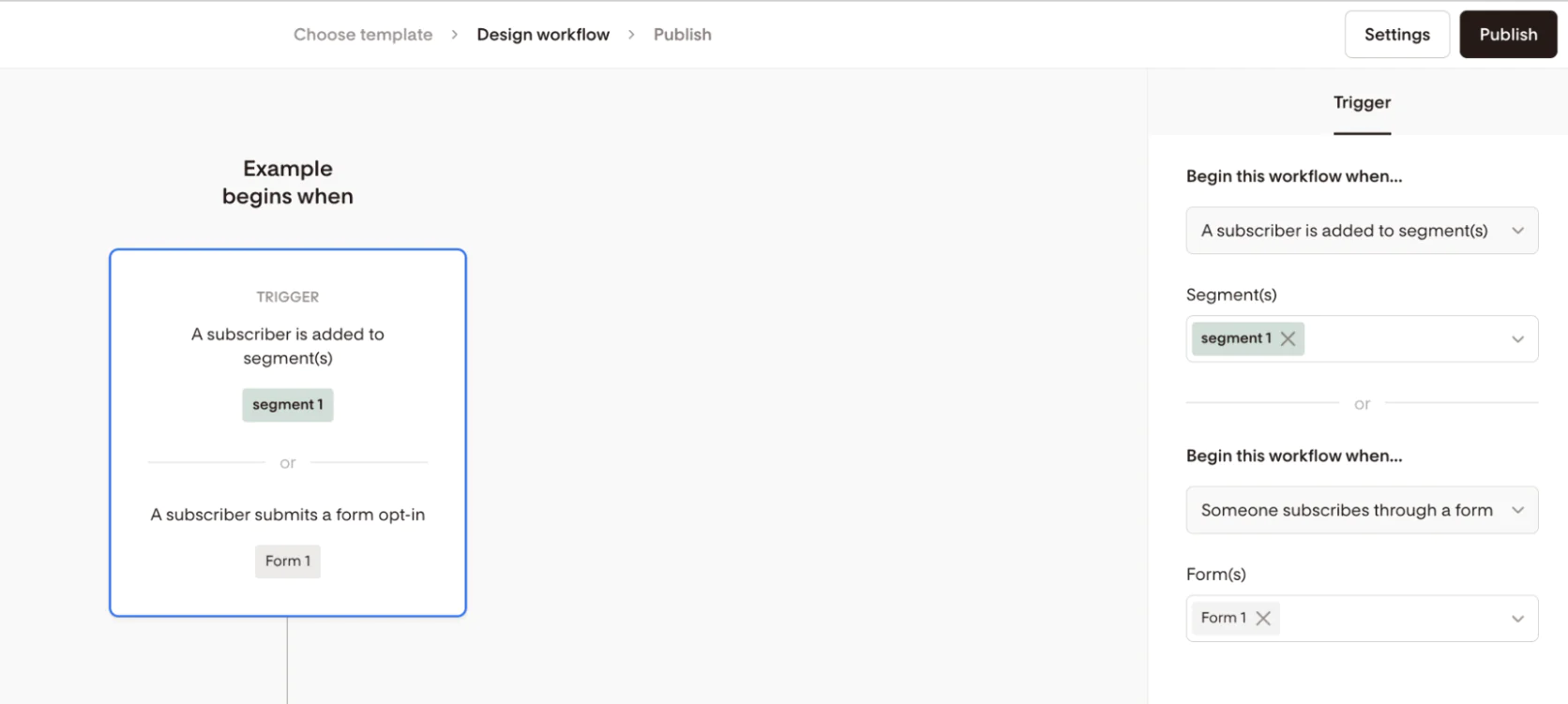
Flodesk’s flow builder
Klaviyo, on the other hand, offers multi-step flows that incorporate both email and SMS. For example, a Klaviyo abandoned cart flow might send an email, then a text, to try and recover a sale. This dual-channel approach gives Klaviyo a leg up on Flodesk for broader marketing automation.
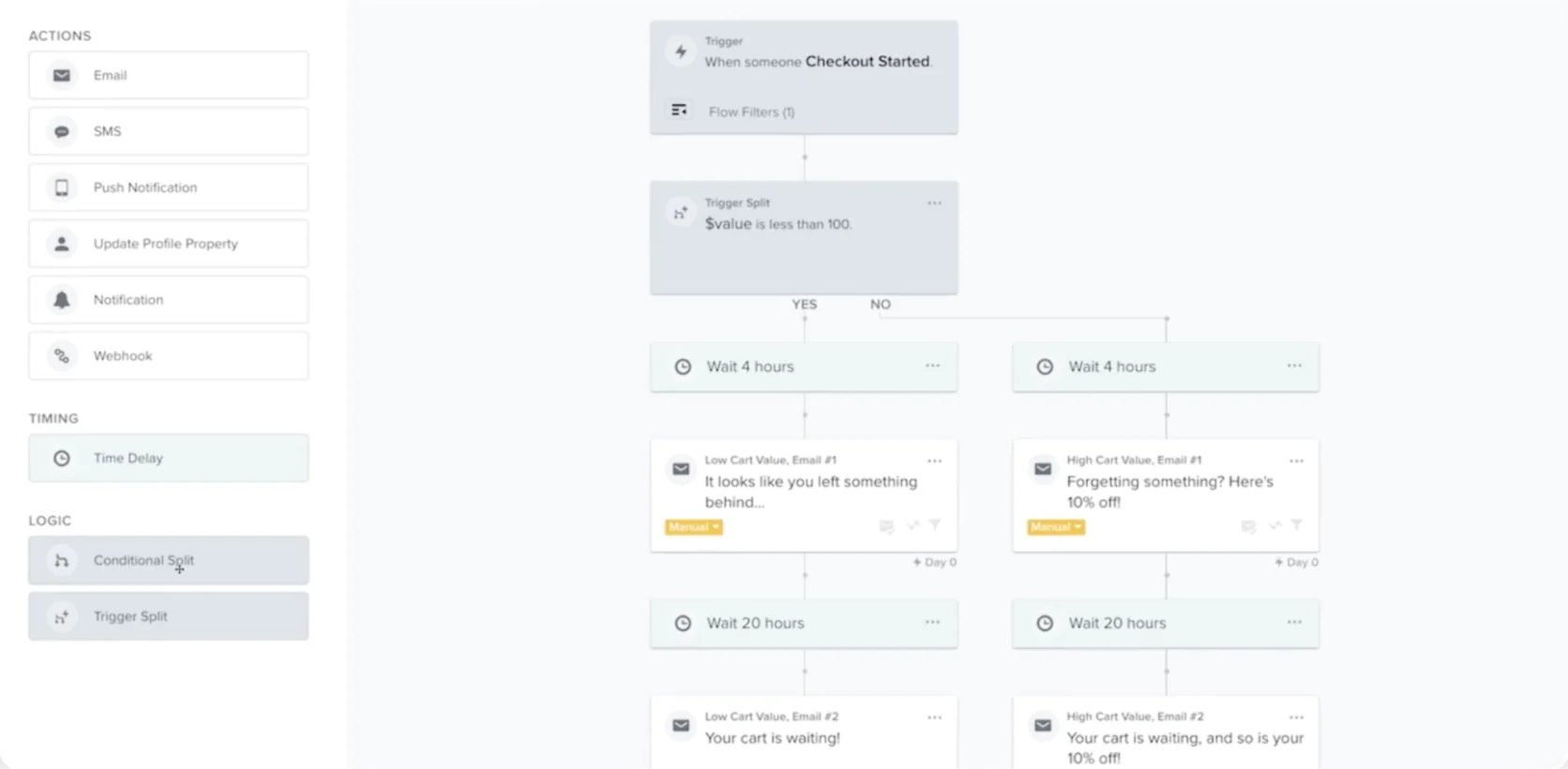
Klaviyo’s flow builder
However, Klaviyo’s reach is still limited to those two channels (plus maybe direct mail via integration). It doesn’t natively tie in things like in-app messages or dynamic website content into the same flow. The unification isn’t as seamless as it could be since there’s no central CDP aligning all channels in real time.
Maestra was built to fill that gap. It enables you to create hyper-personalized flows spanning email, SMS, web, mobile, offline, and ads from one place. With Maestra, you don’t manage each channel in isolation. Instead, you design customer journeys that might start with an email, follow with an SMS, show a website pop-up if they visit your site, and even trigger a targeted Facebook ad—all based on one unified view of the customer.
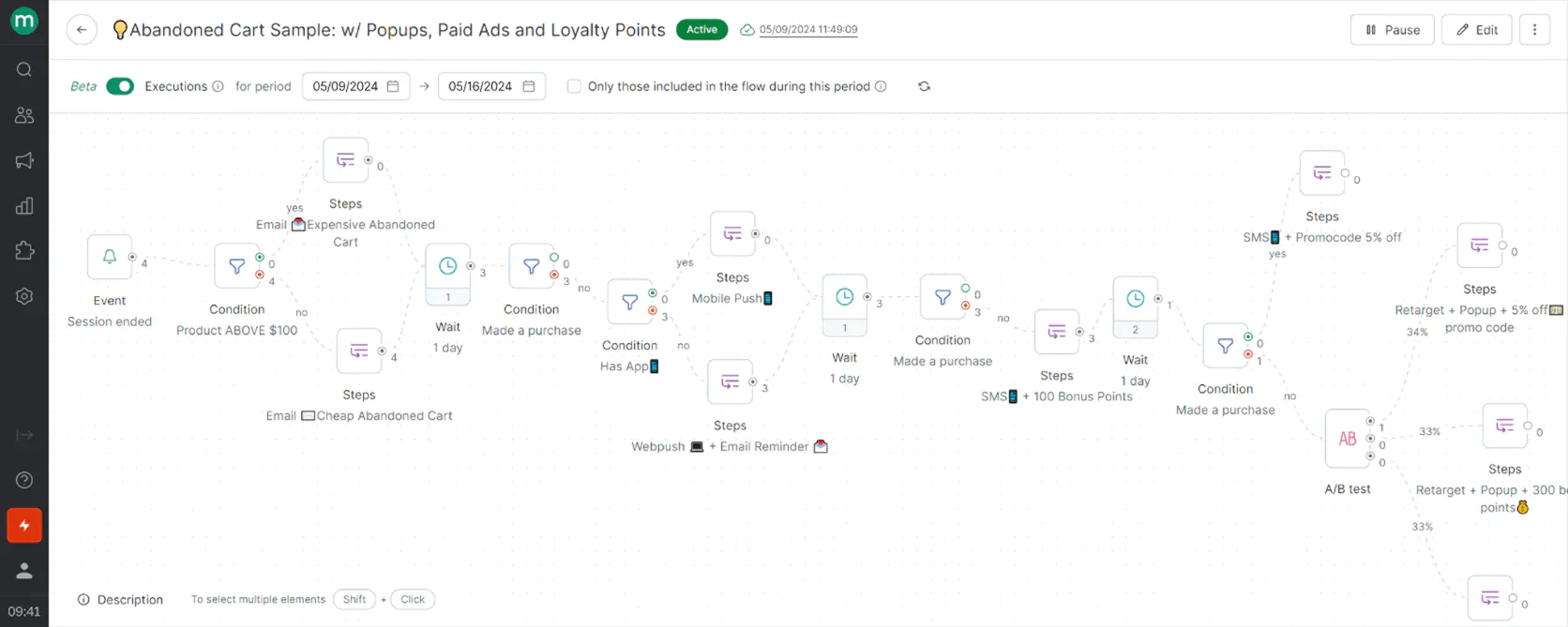
Maestra’s flow example: abandoned card flow with emails, mobile and web pushes, pop-ups, paid ads and loyalty points
Because Maestra’s flows are powered by its real-time CDP, each step can react instantly to customer behavior or changes. For example, if a customer clicked an email and browsed products, Maestra could automatically adjust the next step (maybe skip the SMS and instead show a personalized homepage banner).
The platform is engineered to handle dozens of active automations—some Maestra users run 90+ simultaneous flows without performance issues.
This scale and flexibility are invaluable for a marketing team that wants to set up complex, branching customer journeys. Essentially, Maestra brings enterprise-grade omnichannel automation that neither Flodesk nor Klaviyo can natively match.
Omnichannel Flows Winner: Maestra
Maestra delivers a truly unified omnichannel experience. It connects all your touchpoints—email, SMS, web, mobile app, in-store, and ads—into cohesive conversations, something not possible with Flodesk (single-channel) or even Klaviyo’s email-and-text approach.
For marketing teams, this means you can plan customer-centric journeys rather than channel-centric campaigns. Every interaction informs the next, and messaging stays consistent across channels.
Maestra’s real-time data and scalable automation give it a clear edge in orchestrating omnichannel flows that feel seamless to customer.
Flodesk vs Klaviyo vs Maestra: Customer Data Management & Segmentation
Flodesk
Klaviyo
Maestra
★★
Lists & tags; minimal behavior tracking.
Lists & tags; minimal behavior tracking.
★★★★
E-com events, predictive CLV, flexible segment logic.
E-com events, predictive CLV, flexible segment logic.
★★★★★
Enterprise CDP; AI, nested segments, instant refresh at scale.
Enterprise CDP; AI, nested segments, instant refresh at scale.
In this area, Flodesk is very lightweight. It keeps a list of subscribers with basic info (email, name, etc.) and you can create segments manually (for instance, a segment for customers who filled out a certain form).
But there’s no behavioral data being tracked. Flodesk doesn’t log what products someone bought or which emails they clicked beyond simple analytics. It also lacks advanced segment logic—you mostly segment by attributes or which workflow they’re in.
For a small newsletter, that’s fine, but an e-commerce marketer will find Flodesk’s data capabilities insufficient for targeting campaigns (e.g. you can’t easily pull “all customers who bought item X and haven’t bought Y).
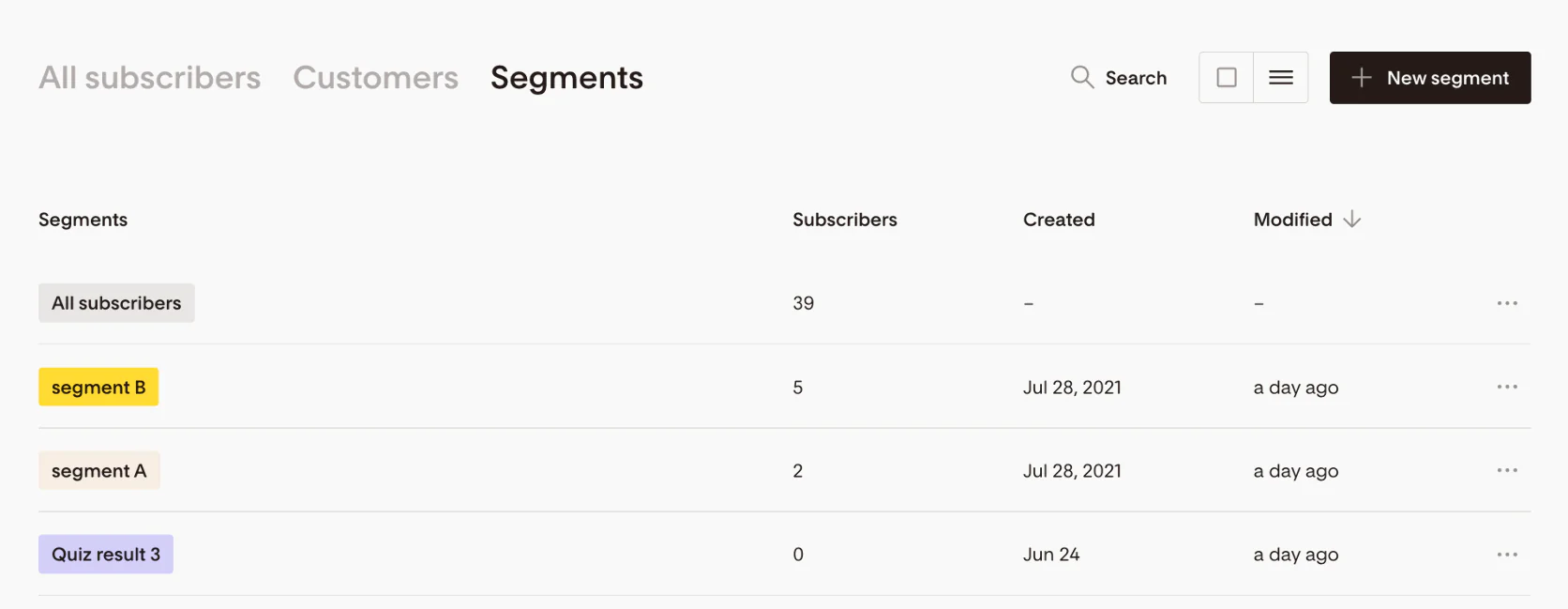
Segment management in Flodesk
Klaviyo takes data much more seriously. When you integrate Klaviyo with your store, it starts pulling in purchase history, website activity (via a tracking snippet), and more. Klaviyo essentially acts as a mini-CDP for e-commerce, consolidating customer data from your shop and marketing touchpoints.
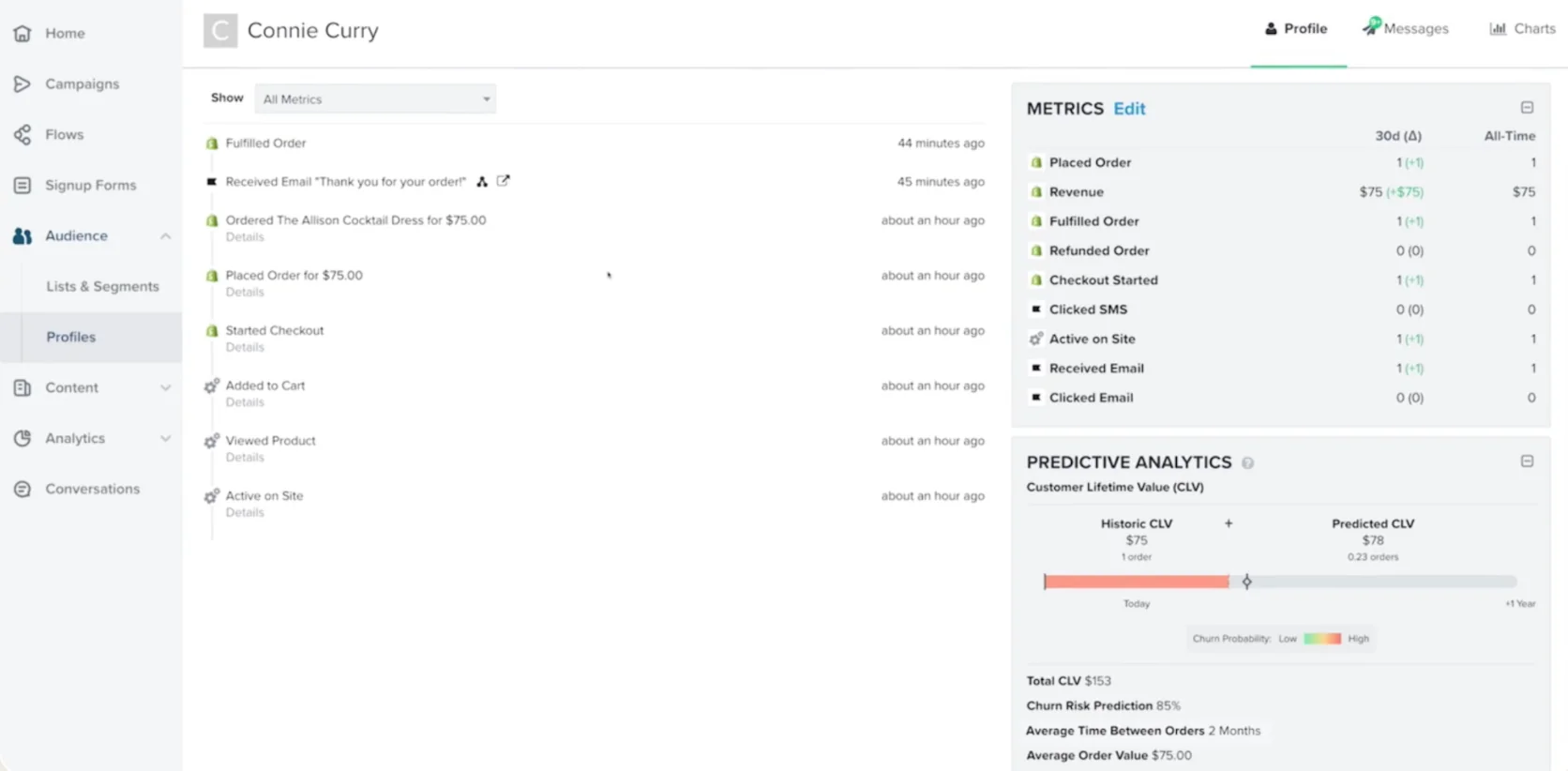
Customer profile in Klaviyo
Its segmentation tools let you slice audiences by behaviors like “placed order at least twice in last 6 months” or “viewed product category = Shoes but never purchased”—very useful for targeted campaigns. It even offers predictive analytics, like estimating a customer’s lifetime value or churn risk, which you can use to create segments (e.g. VIPs, or likely-to-lapse customers).
The limitation is that Klaviyo’s view is mostly limited to online interactions it tracks or that come through integrations. It’s not a full-fledged CDP that would easily take offline data or extensive custom event tracking without technical work.
And as your database grows huge, Klaviyo’s segment refresh speed may lag a bit (most are not truly real-time, though they update fairly frequently).
Still, for most marketing teams, Klaviyo provides powerful segmentation that covers a lot of use cases, far beyond Flodesk’s basic lists.
Maestra’s approach is to give you an enterprise-grade CDP and make it the heart of your marketing. Every customer action—online or offline—streams into Maestra in real time and updates a unified customer profile. This could include point-of-sale transactions, mobile app usage, email clicks, loyalty points, and more.
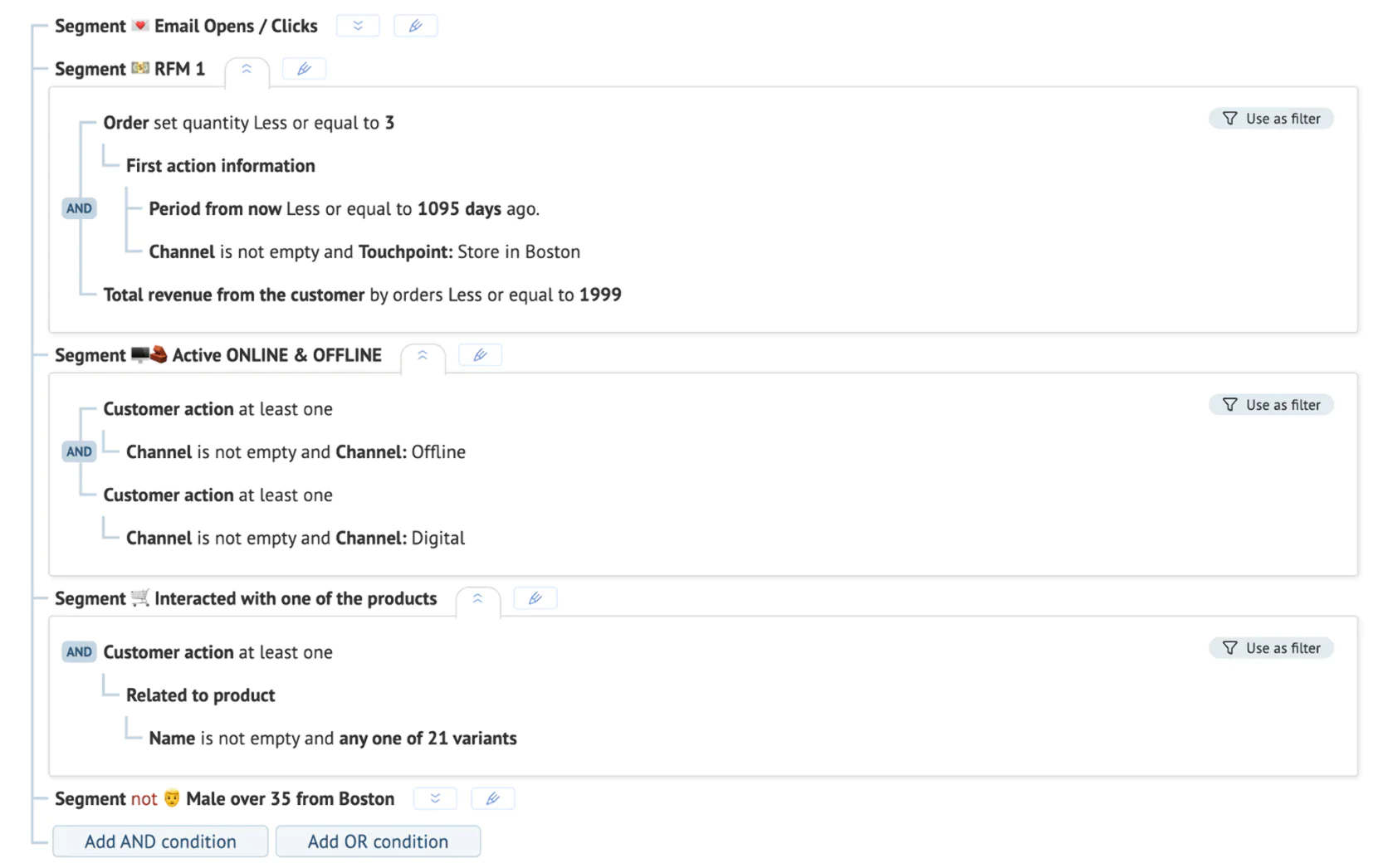
Maestra: user segmentation
Using this rich data, Maestra allows extremely granular segmentation. You’re not limited to a few attributes; you can build segments using sequences of behaviors (e.g. “browsed in category A then purchased in category B within 7 days”) or lifecycle metrics (RFM scores, LTV tiers, etc.).
Maestra’s segmentation engine is also built for speed. Even if you have millions of contacts, segments update in real time as customers interact. That means you could, say, have a segment of “currently on site browsing product X” that a flow can use immediately.
Another standout capability is nested segments and exclusion logic—you can create very precise audiences (like a segment of customers in Segment A but not Segment B, etc.) without workarounds. For a marketing team, this level of precision unlocks a lot of strategies: truly personalized campaigns, dynamic content for micro-segments, automatic suppression of certain audiences from promos, and so on.
In essence, Maestra gives you the kind of data mastery that usually only big companies with custom CDPs have—but out of the box.
Customer Data Management & Segmentation Winner: Maestra
Klaviyo is strong on e-commerce data, but Maestra is on another level by being a real-time CDP and segmentation powerhouse. Maestra ensures all your customer data is unified and actionable in one place, whereas Klaviyo, while very good for an email platform, doesn’t capture every channel or update instantaneously at high scale. Flodesk isn’t really in the conversation here given its rudimentary approach.
For sophisticated segmentation that fuels personalized marketing, Maestra is the clear winner—it equips marketing teams with data capabilities that drive better targeting and, ultimately, better ROI on campaigns.
Flodesk vs Klaviyo vs Maestra: Site Personalization
Flodesk
Klaviyo
Maestra
★
Signup forms only.
Signup forms only.
★★
Targeted pop-ups; no dynamic page content.
Targeted pop-ups; no dynamic page content.
★★★★★
No-code widgets alter banners, blocks, recs in real time.
No-code widgets alter banners, blocks, recs in real time.
Personalizing the website experience is increasingly important for marketers—from showing targeted offers to simply capturing leads at the right moment.
Flodesk’s offerings in this domain are minimal. It provides embeddable signup forms and popup forms to help grow your email list (so you can, for instance, have a “Join our newsletter” popup on your site that feeds into Flodesk).
These forms are nicely designed to match Flodesk’s aesthetic, but that’s about where it ends. Flodesk does not have features to dynamically change content on your site based on who the visitor is or what they’ve done. You can’t, for example, greet a returning customer by name on the homepage or hide/show certain products based on their past purchases—those are well beyond Flodesk’s scope.
Klaviyo’s site personalization largely comes through its signup forms and pop-ups as well. Klaviyo has a form builder that lets you create pop-ups, flyouts, banners, etc., to collect emails or SMS consent, and you can target these forms using some conditions (like show on certain URL, or to first-time visitors vs returning customers). That’s useful for lead capture and even can be used for basic promos (e.g. “Welcome 10% off” pop-up only for new visitors).

Lead form creation in Flodesk
However, Klaviyo doesn’t let you directly swap or personalize the core content of your webpages. It’s not a content management system—you’d need to use something like Optimizely or perform custom coding for deep personalization. In short, Klaviyo improves on-site marketing via pop-ups/forms but doesn’t turn your site into a personalized experience platform on its own.
Maestra treats your website as another channel to personalize, just like email or SMS. Through Maestra, marketers can modify on-site elements for different visitors without coding. For instance, you could have Maestra automatically insert a personalized banner on the homepage for loyalty VIPs (“Welcome back, Jane! You have 200 points to spend”), or change the order of products displayed based on someone’s browsing history.
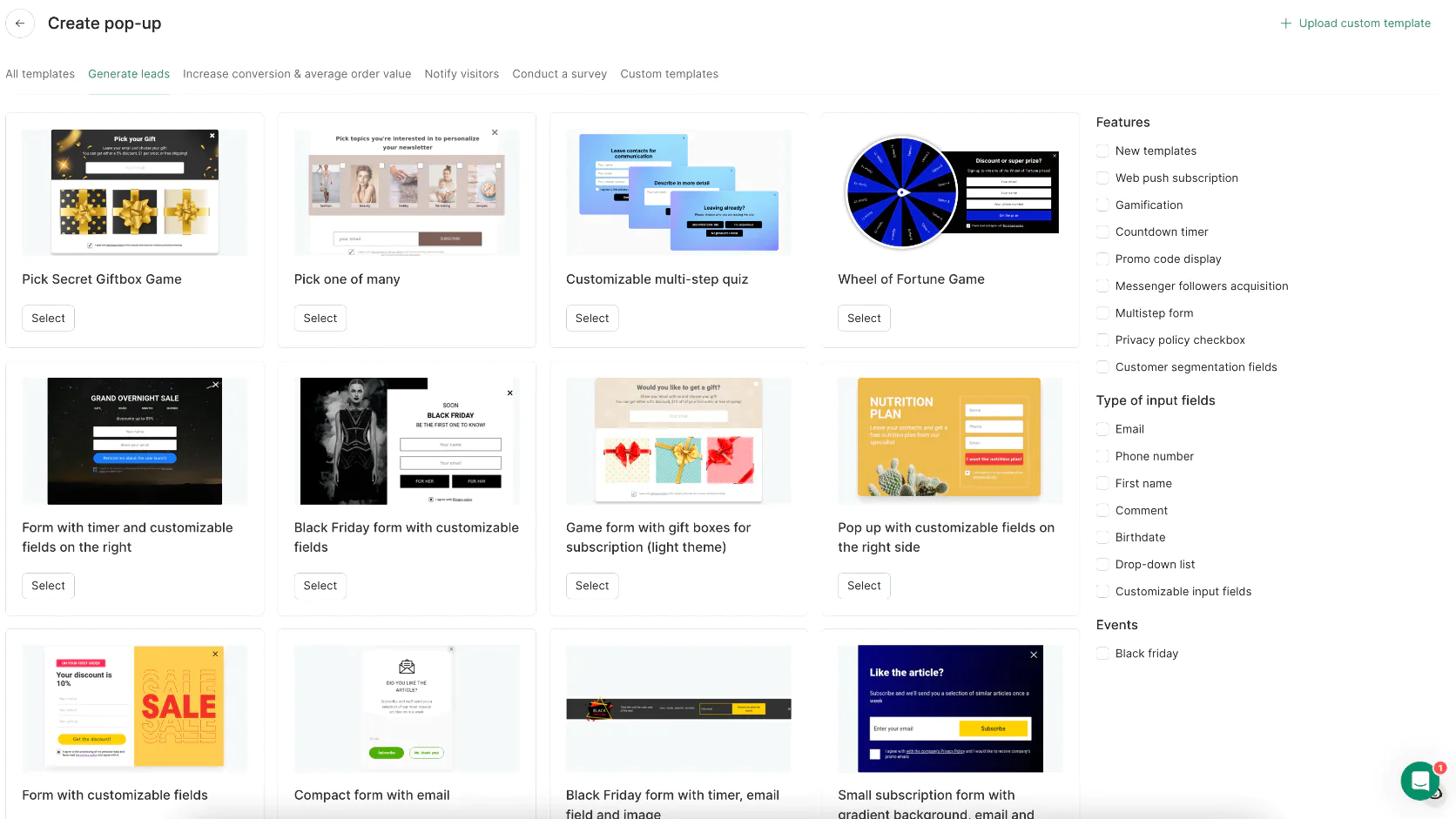
Maestra’s pop-up creation page
It goes beyond just pop-ups (though it has those too). Maestra offers a variety of on-site personalized components—pop-ups, embedded content blocks, recommendation widgets, notification bars, even quizzes and games—that you can deploy and control through the platform.
And thanks to Maestra’s real-time segmentation, these on-site elements can react instantly. For example, if a customer is in a “Winter Sale” segment, the site could show a winter promo banner; once they make a purchase (thus leaving that segment), Maestra could stop showing that banner—all in that same session.
Essentially, Maestra empowers marketing teams to tailor the web UX for each user on the fly. This level of personalization can significantly boost engagement and conversion, but normally requires either expensive personalization software or lots of dev work. With Maestra, it’s part of the package: the site becomes as dynamic as your emails, based on the rich data Maestra has about each visitor.
Site Personalization Winner: Maestra
No surprise here—Maestra is built for real-time site personalization, whereas Flodesk and Klaviyo offer only the basics (mostly for lead capture). For a marketing team, Maestra’s ability to directly influence what each customer sees on the website is a game-changer.
It means your site is not a static brochure; it’s a responsive, targeted channel that works together with your emails and other efforts. The others can help get people to the site, but once they’re there, Maestra takes the win by optimizing and personalizing that on-site journey in ways Flodesk and Klaviyo simply cannot.
Flodesk vs Klaviyo vs Maestra: Email
Flodesk
Klaviyo
Maestra
★★★
Gorgeous designer; basic automations, no A/B.
Gorgeous designer; basic automations, no A/B.
★★★★
Full automation, A/B, product blocks, solid deliverability.
Full automation, A/B, product blocks, solid deliverability.
★★★★★
Lean HTML, dynamic content, AMP, high throughput & testing.
Lean HTML, dynamic content, AMP, high throughput & testing.
Flodesk’s calling card is its beautiful email designs and ease of use. Even without coding skills, marketers can produce elegant, image-rich newsletters and promotions that look professionally designed. The editor is intuitive and the templates are top-notch aesthetically.
Also, Flodesk’s flat-rate pricing means you can send unlimited emails without worrying about cost per send, which is appealing if you have a large list and a lot of content (newsletters, etc.) to send out.
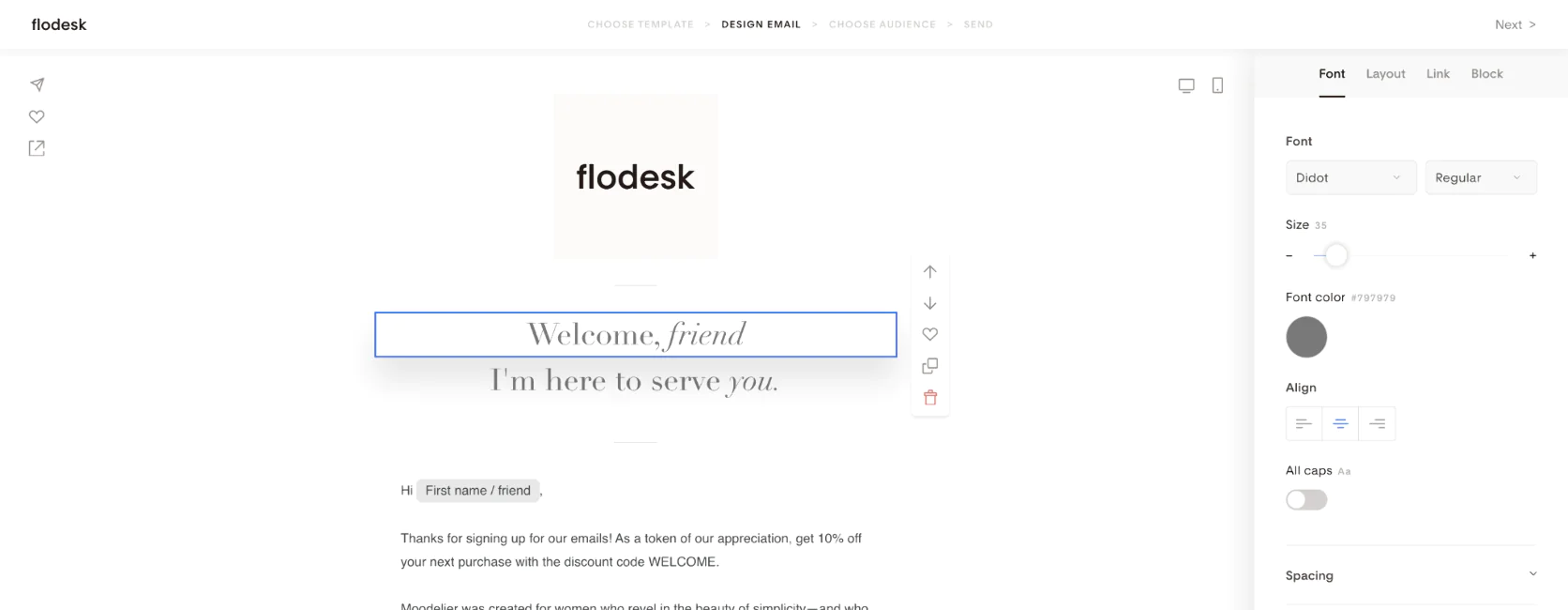
Flodesk’s email editor
That said, Flodesk is missing many advanced email features. For one, it doesn’t support complex automation triggers—you can do a welcome series or time-based drip, but you can’t easily set up behavior-based triggers beyond basic link clicks or form subscribes.
It also doesn’t have built-in A/B testing of emails (a key feature to optimize subject lines and content), nor does it provide detailed deliverability tools (like managing suppression lists, dedicated IPs, etc., which larger senders might need).
In terms of personalization, you can insert someone’s name or basic merge fields, but you’re not going to have dynamic product recommendations or heavily segmented content in Flodesk emails—not without doing it manually for each segment.
Summing up Flodesk Email: gorgeous and simple, but not smart. Great for small brands focused on branding; limiting for data-driven campaigns.
Klaviyo, in contrast, is a powerful email marketing platforms, especially for e-commerce. With Klaviyo, you get a drag-and-drop email builder as well, and while its templates are perhaps more utilitarian than Flodesk’s stylish ones, you have immense flexibility.
You can pull in product information from your store, dynamically populate emails with product recommendation blocks. Marketers can drag a “product feed” block into an email template, choose a feed like “recommendations” or “bestsellers,” and Klaviyo will populate that section dynamically for each recipient.

Klaviyo’s email composer
Klaviyo also offers strong automation capabilities for email. You can trigger flows off dozens of events: placed order, viewed product, added to cart but didn’t purchase, etc. and chain together emails (and texts) accordingly.
It supports A/B testing within flows and campaigns, so you can continually optimize subject lines, send times, or content.
On the deliverability front, Klaviyo provides tools like domain authentication (to help emails not land in spam) and an email health dashboard with benchmarks. Many users also appreciate that Klaviyo’s reporting ties email performance to actual sales—it will tell you “this campaign generated $X in revenue,” which is great for understanding impact.
The only knocks on Klaviyo’s email might be that advanced features (like AMP emails for interactive content) are not present, and that the email editor code isn’t as lean as Maestra’s (so very long emails can sometimes clip in Gmail—a common issue for many ESPs).
But overall, Klaviyo sets the bar for email marketing among these three, with a balance of user-friendliness and advanced functionality.
Maestra’s email capabilities were built to rival dedicated ESPs and even go a step further. It has its own drag-and-drop email composer, which, much like Flodesk, allows for pixel-perfect designs—but under the hood, Maestra is optimizing everything for performance.
Emails from Maestra are generated with clean HTML/CSS to avoid the dreaded "[Message Clipped]" issue in Gmail and to minimize chances of being flagged as spam.
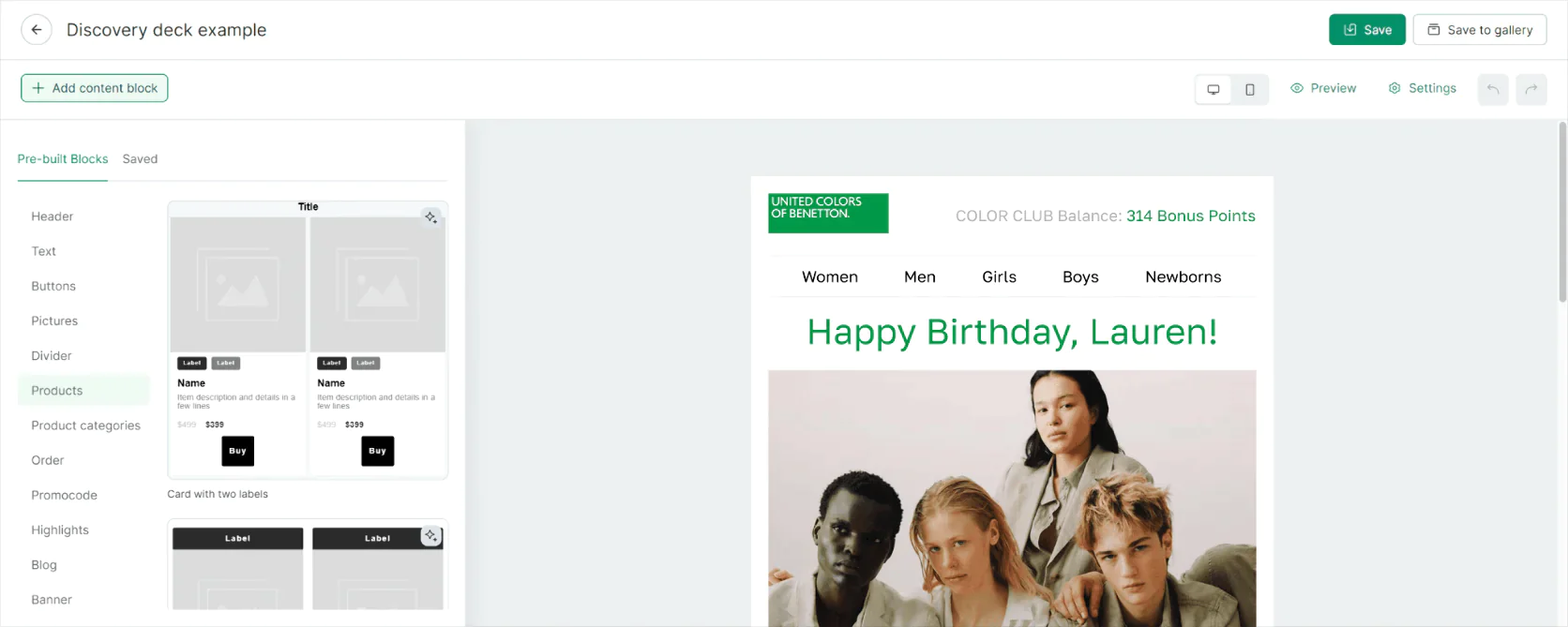
Maestra’s visual email composer
When it comes to personalization, Maestra truly leverages its integrated data. You can insert dynamic content blocks that tailor themselves to each recipient at send-time (far beyond just a first name). For example, one recipient’s email can highlight products in their browsing history, while another sees content related to a loyalty reward—all from one email template.
Naturally, Maestra includes all the bread-and-butter features: A/B testing, detailed email performance analytics, deliverability monitoring, etc. It also has high sending throughput, meaning if you need to send a half-million emails quickly, Maestra can handle it. I
In short, Maestra gives you enterprise email marketing as part of the package, so you’re not trading anything away by not using a separate ESP. It’s built to maximize engagement with advanced tactics (dynamic segmentation, AMP interactivity, etc.) while ensuring your beautifully personalized emails actually reach the inbox.
Email Winner: Maestra
This is a close call between Maestra and Klaviyo. Both offer powerful email marketing tools that far exceed Flodesk’s capabilities. Klaviyo is a proven leader for e-commerce email, but Maestra matches those strengths and adds more native personalization and technical optimizations.
Because Maestra can draw on richer real-time data and automate deeper personalization (and because its email code is remarkably optimized for deliverability), we’d give Maestra the slight edge.
For a marketing team that wants the absolute most sophisticated email program—integrated with everything else—Maestra is the winner. That said, Klaviyo remains an excellent email platform in its own right, while Flodesk is best suited for simpler needs.
Flodesk vs Klaviyo vs Maestra: SMS
Flodesk
Klaviyo
Maestra
★
None—needs third-party.
None—needs third-party.
★★★★
Integrated SMS with consent, flows, analytics.
Integrated SMS with consent, flows, analytics.
★★★★★
Native, omnichannel-aware SMS with link tracking & testing.
Native, omnichannel-aware SMS with link tracking & testing.
Flodesk does not include an SMS marketing feature. If you want to send text messages to customers, you’d have to use a separate service (like Twilio, EZ Texting, etc.) and there’s no direct integration to trigger those texts from Flodesk’s workflows.
Klaviyo has made SMS a core part of its offering in recent years. Inside Klaviyo, you can build SMS campaigns and automated flows very much like you do emails. For example, you can set up an abandoned cart flow that sends a text message if the customer is subscribed to SMS, or a birthday flow that sends a special promo code via SMS. The platform handles consent management and opt-out for you (which is critical for legal compliance).
One of the advantages here is that your SMS lives in the same system as your email, so you can coordinate timing—e.g. Klaviyo can ensure you don’t bombard someone with both an email and SMS at the exact same time, or you can set logic like “if they opened the email, don’t send the SMS,” within a unified flow. That’s a lot harder if your SMS and email are in different tools.
Klaviyo’s SMS is currently strongest for basic marketing texts: product recommendations, cart reminders, sale alerts, back-in-stock notifications, etc. It may not have some fringe features like MMS coupons or advanced AI copy suggestions (some specialized SMS tools do these), but it covers what most e-commerce marketers need.
Overall, Klaviyo gives marketers a reliable, integrated way to do text marketing alongside email, which Flodesk lacks entirely.
Maestra includes SMS as a native channel and, more importantly, ties it into the omnichannel strategy. You can not only send one-off campaigns via SMS (say, a flash sale text to all opted-in users), but also use SMS throughout Maestra’s automation flows.
What’s powerful is the context awareness: Maestra’s CDP knows if a customer has seen an email or engaged on the website, and you can set conditions for SMS accordingly. For instance, if a customer ignored an email offer, Maestra might send an SMS follow-up the next day; conversely, if they clicked the email, maybe it skips the SMS. This avoids duplication and improves customer experience.
Maestra’s SMS supports bulk and transactional sends with high throughput, so sending tens of thousands of messages quickly (for a big promotion or urgent alert) is fine. It also has nice touches for marketing, like built-in URL shortening and click tracking, so you can include links in texts and see who clicked.
You can personalize texts with any customer data (name, points balance, etc.), which again leverages the CDP. Additionally, Maestra can recognize users across devices—meaning if they click a link on their phone, Maestra knows it’s the same person as their email profile, unifying the data. These kinds of details help with attribution and sequencing across channels.
In summary, Maestra’s SMS is enterprise-grade and deeply integrated into the customer journey, whereas Klaviyo’s SMS is strong but more siloed (integrated only with email) and Flodesk has none.
SMS Winner: Maestra
Maestra wins for SMS because it treats text messaging as one part of a larger conversation, fully synced with other channels.
Klaviyo is a very capable runner-up—it has solid SMS marketing features, particularly for e-com needs, and definitely outdoes Flodesk which doesn’t compete here at all. But Maestra’s approach of weaving SMS into omnichannel flows (with real-time decisioning on when to text a customer and what to say) means higher relevance and less risk of over-messaging.
For a marketing team, that level of control and integration can make SMS campaigns significantly more effective and customer-friendly.
Flodesk vs Klaviyo vs Maestra: Website and Email Product Recommendations
Flodesk
Klaviyo
Maestra
★
Manual inserts only.
Manual inserts only.
★★★
AI recs in email; none on site.
AI recs in email; none on site.
★★★★★
AI recs in email and on-site; rule tuning.
AI recs in email and on-site; rule tuning.
Flodesk, unfortunately, does not have any built-in product recommendation features. In a Flodesk email, if you want to show products, you’d have to manually design that section. And on the website side, Flodesk doesn’t touch product recommendations at all (that would usually be handled by your e-commerce platform or another app).
Klaviyo offers a pretty neat capability for email recommendations: it can automatically include personalized product suggestions in emails using data from your store and other buyers’ behavior. Specifically, Klaviyo has a feature called “Products a customer may also like.” Marketers can drag a “product feed” block into an email template, choose a feed like “recommendations” or “bestsellers,” and Klaviyo will populate that section dynamically for each recipient.
However, in terms of website product recommendations, Klaviyo doesn’t provide widgets or carousels for on-site use. Typically, you’d rely on Shopify’s built‑in recommender or a dedicated app for on‑site personalization. Klaviyo can integrate with certain on‑site product rec tools via its ecosystem of integrations, but it’s not plug‑and‑play for web recs.
Maestra brings product recommendations to both email and web, with a unified AI brain behind it. Within Maestra’s platform, you can set up product recommendation blocks that use real‑time algorithms considering each customer’s browsing history, past purchases, and even attributes like brand or category affinities. Maestra provides a library of algorithms that you can apply.
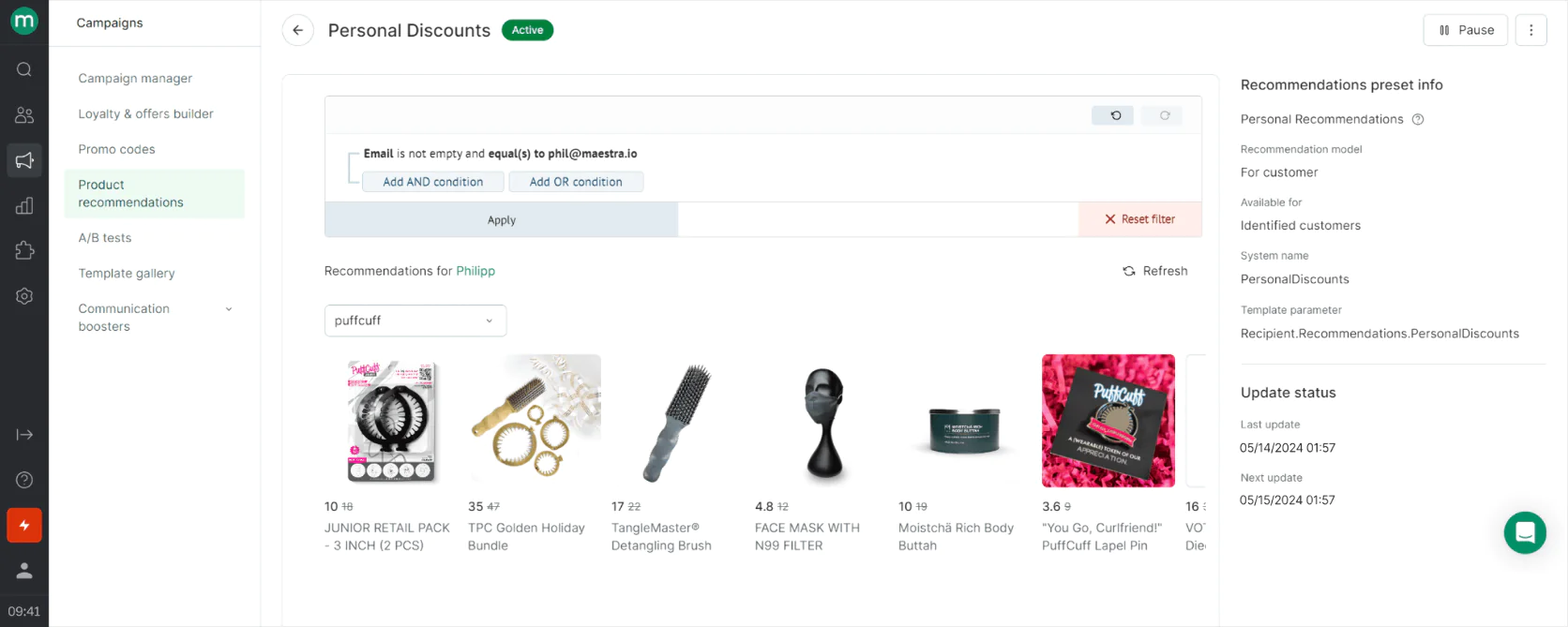
Personal product recommendations in Maestra
Importantly, these recommendations can be used in emails and on your site interchangeably. So the product grid a user sees on the homepage could be personalized by Maestra, and the next email they get could contain a similar style of personalized suggestions—creating continuity.
Because Maestra’s CDP tracks real‑time behavior, if a customer’s preferences shift (say they start browsing a new category), the recommendations will adjust accordingly in the moment.
Additionally, Maestra allows rule‑based tweaks: for instance, you can ensure the algorithm doesn’t recommend out‑of‑stock items, or you can manually pin certain products as “always recommend these to high‑value customers,” etc. It’s a nice blend of automation and marketer control.
The upshot for a marketing team is that Maestra can automatically merchandise both your website and emails for each individual—potentially increasing upsells and cross‑sells without any manual curation after the initial setup.
Website and Email Product Recommendations Winner: Maestra
Maestra clearly leads in recommendation capabilities because it provides an integrated, AI‑driven solution across channels.
Klaviyo does a commendable job with personalized email product recs (something Maestra also does, and arguably with more sophistication given the real‑time data access). But Klaviyo can’t extend that to on‑site experiences by itself. Maestra’s ability to consistently recommend the right products whether the customer is reading an email or browsing your site is a major advantage.
Flodesk, lacking any such features, isn’t in contention.
So for maximizing product discovery and sales through smart recommendations, Maestra wins.
Flodesk vs Klaviyo vs Maestra: Loyalty Programs
Flodesk
Klaviyo
Maestra
★
No native program.
No native program.
★
No native program.
No native program.
★★★★★
Points, tiers, referrals baked in; auto-reward logic.
Points, tiers, referrals baked in; auto-reward logic.
Neither Flodesk nor Klaviyo includes a loyalty program module out-of-the-box.
Flodesk has no concept of points or customer status beyond what you might manually track. If you wanted a loyalty program while using Flodesk, you’d have to rely on another app.
Klaviyo also does not run loyalty programs itself. Instead, Klaviyo often is used in tandem with loyalty solutions: for example, many brands use Smile.io or LoyaltyLion and then integrate those with Klaviyo so that Klaviyo can send the loyalty emails (points earned, reward available, etc.) and segment people by loyalty tier.
The upside is you can still deliver a lot of loyalty messaging through Klaviyo, but the downside is you’re paying for and managing a separate tool, and there might be a slight lag or complexity in keeping the data synced.
Maestra includes a full loyalty and rewards program as part of its platform. This means you can define how customers earn points (purchases, certain actions, maybe even things like social media engagement), set up VIP tiers or levels, and determine rewards (like coupons, free products, early access, etc.) all within Maestra.

Maestra’s promotions rule engine
The beauty of having it integrated is that the loyalty program doesn’t sit in a silo—it’s woven into your marketing flows. For example, Maestra can trigger an email when a customer is, say, 10 points away from the next VIP tier, encouraging them to make another purchase. Or on the website, it can show a personalized message like “You have 50 points—redeem for a $5 discount now?” during checkout. Because all the data is first-party in Maestra, you avoid the integration headache.
Additionally, Maestra’s loyalty program is very flexible: you can award points for more than just purchases (reviews, referrals, birthdays, etc.) and you can tailor the program to segments (perhaps double points events for specific customer groups). It even allows combining loyalty with promotions, e.g. giving bonus points if someone buys during a specific promo period. For marketers, this is gold because you can get really creative in how you drive retention.
Another Maestra perk: loyalty status can influence every other channel automatically—your Facebook ads could exclude loyal customers from generic offers (because they’ll get loyalty-specific ones), your SMS can send early access codes to VIPs, and so on, all defined in one system.
Loyalty Programs Winner: Maestra
This one is straightforward: Maestra is the only one of the three with a built-in loyalty program capability. That makes it the winner by default, but also by merits—its loyalty features are robust and deeply integrated into marketing campaigns.
By contrast, Klaviyo and Flodesk require external tools to offer anything similar, which means more complexity and potentially fragmented customer experiences.
If a unified, effective loyalty program is on your wishlist, Maestra is the platform in this lineup that delivers it without requiring third-party add-ons.
Flodesk vs Klaviyo vs Maestra: Mobile and Web Push Notifications
Flodesk
Klaviyo
Maestra
No support for mobile or web push notifications
Supports basic mobile app push notifications
Comprehensive push notification capabilities including both mobile app and web push
Flodesk does not support push notifications in any form. Since Flodesk has no mobile app component and no web SDK for push, you can’t send browser notifications or app push messages with it.
Klaviyo has mobile push notifications capabilities, which they introduced to support brands with mobile apps. If your brand has an app, you can integrate the Klaviyo SDK and then use Klaviyo to send push notifications to those app users. This is great because it means email, SMS, and mobile push can all be coordinated in Klaviyo’s flows.
However, Klaviyo notably does not support web push notifications natively
Maestra includes both web and mobile push as channels in its omnichannel repertoire. With Maestra, you can prompt visitors on your website to allow browser notifications, and then use Maestra to send those web push messages (for example, “Your order is out for delivery!” or “Price drop on an item you viewed”). Also, if you have a mobile app, Maestra can send mobile push notifications through its unified system as well.
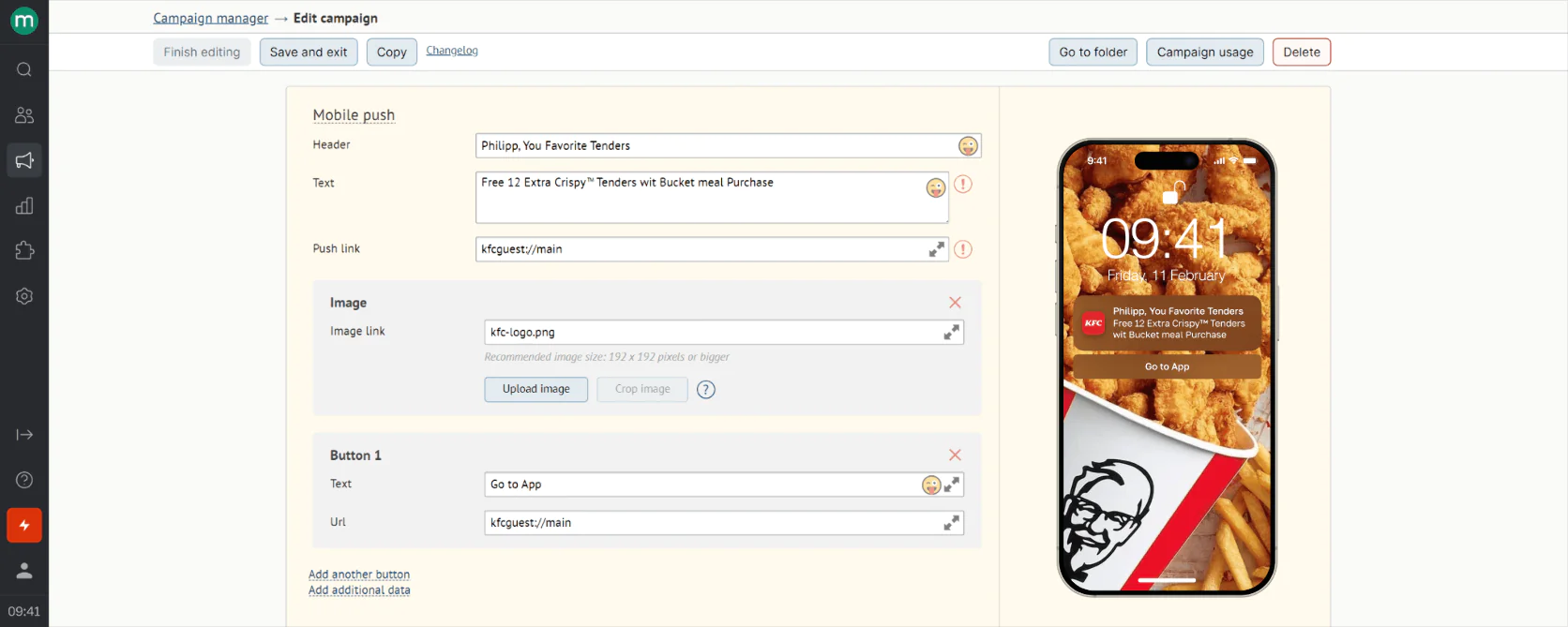
Push notifications in Maestra
The benefit of having push integrated is, again, the coordination and segmentation. Maestra’s push campaigns can be highly targeted—e.g. send a push notification about product X to users who looked at product X but didn’t buy. And because Maestra knows if that person later bought the item in store or via another channel, it could automatically cancel or adjust a scheduled push (preventing irrelevant messages).
Maestra also supports rich push content: you can include images, emojis, and call-to-action buttons in your push notifications, making them more engaging. Plus you get analytics on push delivery and engagement as part of the overall dashboard.
For a marketing team, web push in particular can be a nice additional touchpoint—it’s free to send and can reach customers in real-time with brief alerts. Mobile push is more niche (since not every brand has an app), but if you do, Maestra handles that channel in stride.
Mobile and Web Push Notifications Winner: Maestra
Maestra wins here thanks to its comprehensive support for both web and mobile push and the sophisticated way it integrates push into customer journeys.
Klaviyo deserves credit for adding mobile push, which is useful for brands with apps, but it falls short by missing web push. Flodesk, having no push at all, isn’t competitive in this category. For a truly omnichannel approach that includes timely push notifications to re-engage customers on their browsers or phones, Maestra is the clear leader among these three.
Flodesk vs Klaviyo vs Maestra: Ad Optimization
Flodesk does not have any features for paid ad integration or optimization. It doesn’t sync audiences to ad platforms, nor does it import ad performance data.
Klaviyo provides strong integrations with advertising channels, particularly Facebook and Instagram (via Meta) and Google Ads. With Klaviyo, you can take any segment (say “Added to Cart in last 30 days, Not Purchased”) and automatically push it to Facebook Custom Audiences or Google Customer Match. This is huge for marketers because it keeps your ad targeting aligned with your most current customer data.
Klaviyo also leverages its data for lookalike modeling—you can send high LTV customer lists to Facebook to find similar people. On the Google side, uploading an email list can help with Gmail sponsored promotions or YouTube ads targeting.
Additionally, Klaviyo’s tracking script can pass back conversion data to Facebook/Google for attribution if set up.
In summary, Klaviyo makes your ads smarter by syncing the right audiences, but it’s not an “ad tool” per se—it optimizes targeting, not the creative or bidding.
Maestra takes ad integration to an even more advanced level. Like Klaviyo, Maestra can sync customer segments to Facebook, Google, and other ad platforms continuously. But because Maestra’s CDP is real-time and includes more data, you can create very refined audiences.
For instance, Maestra could create an audience of “female VIP customers in NYC who haven’t bought in 90 days” and sync that to Facebook for a re-engagement ad, and if any of those customers purchase in-store, Maestra would catch it and remove them from the audience quickly (since it captures offline too).
Another aspect is Maestra can respond to ad interactions: if someone comes in via a Facebook lead form, Maestra can ingest that lead data instantly (through integration) and trigger flows.
The main benefit is that Maestra treats ad channels as a natural extension of your marketing. All your lookalikes, retargeting pools, suppression lists, etc., can be governed by Maestra’s brain, ensuring you’re not overspending.
Some Maestra users leverage it to reduce ad costs by excluding existing engaged customers from broad campaigns, focusing spend on high-potential new audiences, and even creating dynamic audiences for seasonal campaigns that update automatically. These are things you’d need either manual work or a separate customer data platform to do normally.
Essentially, Maestra aims for end-to-end marketing—including making your ad spend more efficient by using your first-party data.
Ad Optimization Winner: Maestra
Maestra wins in ad optimization because it not only syncs audiences like Klaviyo does, but does so with more real-time nuance and across more data points. For a marketing team, this means better targeting and less waste in paid campaigns.
Klaviyo is a close second, offering very valuable audience syncing that many brands use to great effect. If you’re running Klaviyo, you absolutely should use that feature to improve your ads.
Flodesk doesn’t assist with ads at all, so it’s not in the running.
All in all, Maestra provides the most comprehensive integration with paid media as part of its unified platform, making it the winner here.
Flodesk vs Klaviyo vs Maestra: Reporting and Attribution
Flodesk
Klaviyo
Maestra
★★
Opens & clicks only.
Opens & clicks only.
★★★★
Email/SMS revenue attribution, flow analytics, benchmarks.
Email/SMS revenue attribution, flow analytics, benchmarks.
★★★★★
Cross-channel dashboards, custom models, control-group lift.
Cross-channel dashboards, custom models, control-group lift.
Flodesk keeps reporting fairly basic. In the Flodesk dashboard, you can see metrics like email open rates, click-through rates, how many subscribers you gained, etc. It’s enough to gauge the performance of individual email campaigns or forms.
But you won’t find advanced analytics or customizable reports. For example, Flodesk won’t show you revenue per email (since it doesn’t integrate with sales data deeply), nor does it have multi-channel attribution (since it doesn’t handle multiple channels). You also can’t really create custom reports or dashboards; you get what’s provided.
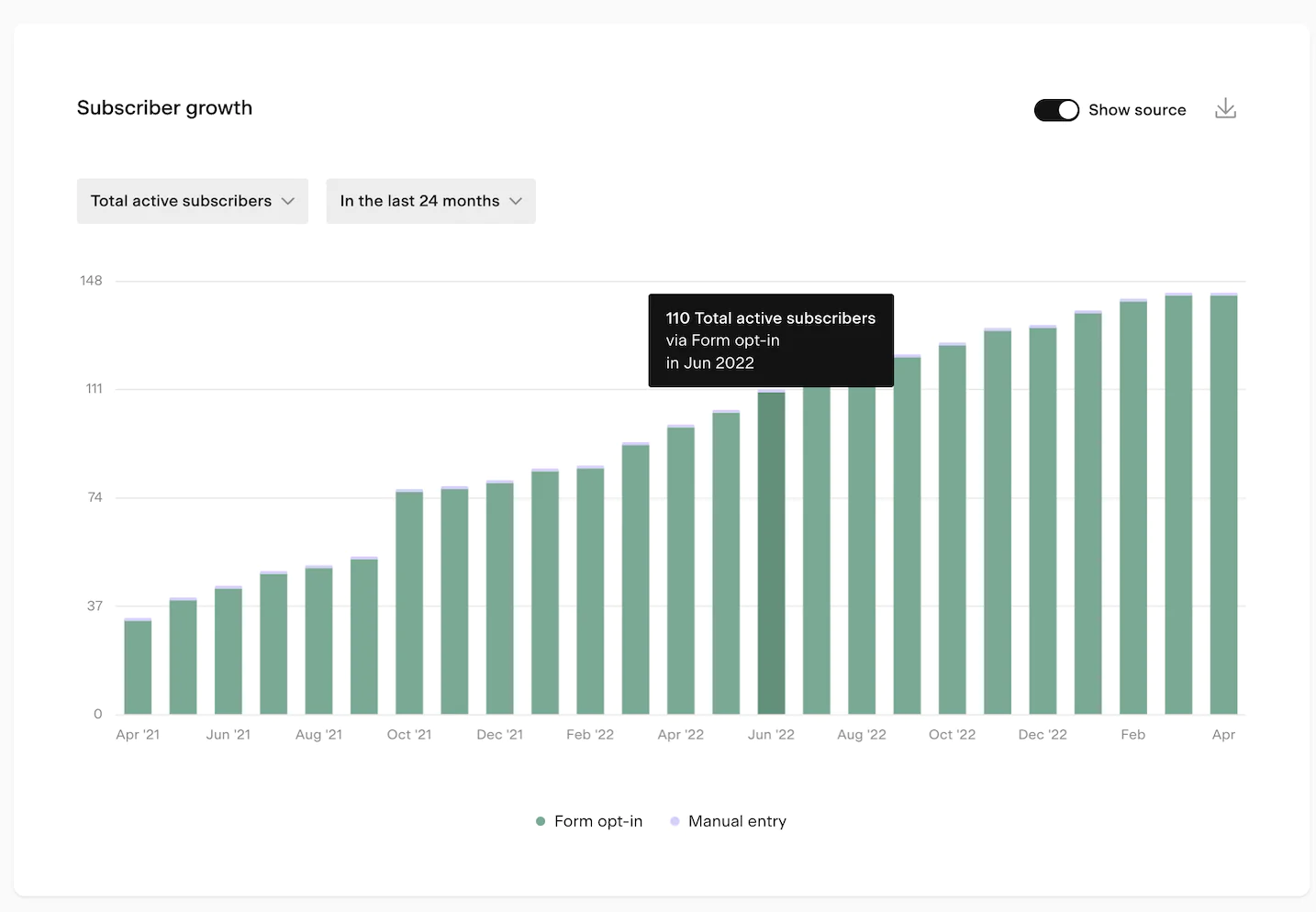
Subscribers growth dashboard in Flodesk
For a small operation, this is fine—you can tell if people liked your email or if your list is growing. But as marketing becomes more sophisticated, Flodesk’s reporting doesn’t answer bigger questions like “which campaign drove the most sales last quarter?” or “what’s our conversion rate from welcome series to first purchase?”
Klaviyo offers robust analytics for the scope it covers. In Klaviyo, each email campaign report will show opens, clicks, unsubscribes, and crucially, revenue attributed to that campaign (if you’ve integrated your store, Klaviyo tracks who purchased after receiving the email).
For flows (automations), Klaviyo shows metrics per email in the flow and overall conversion rates. You can see which subject lines perform better in an A/B test, etc.
Klaviyo also recently added benchmarks—it will compare your email performance to industry averages which is handy.
While Klaviyo’s reporting is largely preset, you can do some customization by filtering data or building segments and then measuring their activity (like you might create a segment of “holiday shoppers” and then see their lifetime value in Klaviyo).
Attribution-wise, Klaviyo typically uses a last-touch model for its revenue reporting: if someone clicked an email and bought within the default window (usually 5 days), it counts that revenue to the email. It also has a setting for viewed (opened) attribution. This is great for understanding email and SMS impact, but it won’t capture if multiple touches contributed (no multi-touch attribution).
There’s no native dashboard that includes, say, ad spend or Google Analytics data—Klaviyo focuses on what’s in Klaviyo. However, you can export data or use Klaviyo’s API to feed a separate BI tool if needed.
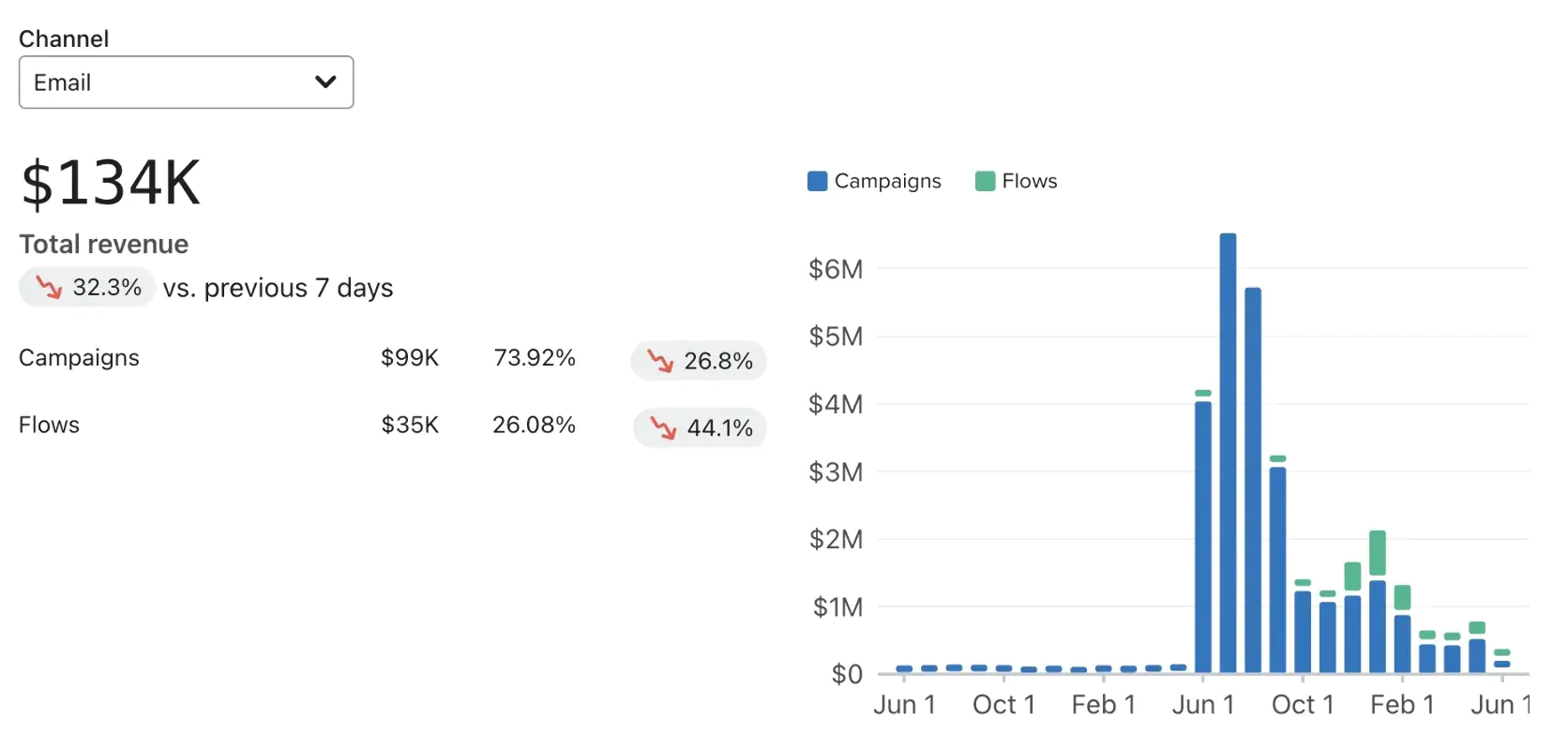
Fragment of Klaviyo’s business review dashboard
Overall, marketers using Klaviyo get a pretty clear picture of how their campaigns and flows are performing and can tie a decent chunk of revenue to their efforts, which is motivating and useful for optimization.
Maestra, by virtue of unifying channels, provides a more holistic view.
In Maestra, you can track the performance of each campaign across all channels it touched. For instance, a promotion flow that involved an email, an SMS, and a push notification—Maestra would show you the combined outcome (total conversions, revenue) and even break down how each touch contributed.
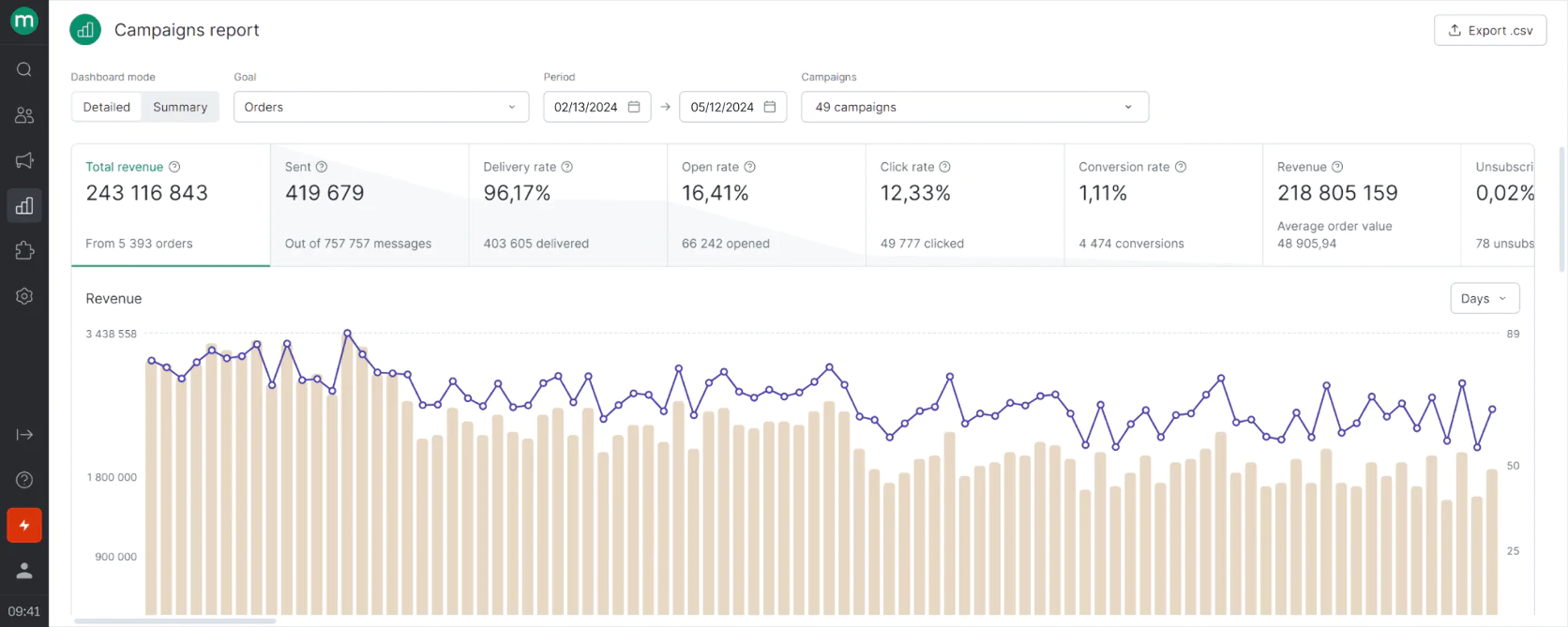
Maestra also includes features like control groups for flows (so you can hold out a random sample of customers to not receive a certain campaign and see baseline vs lift, which is very insightful for proving campaign impact).
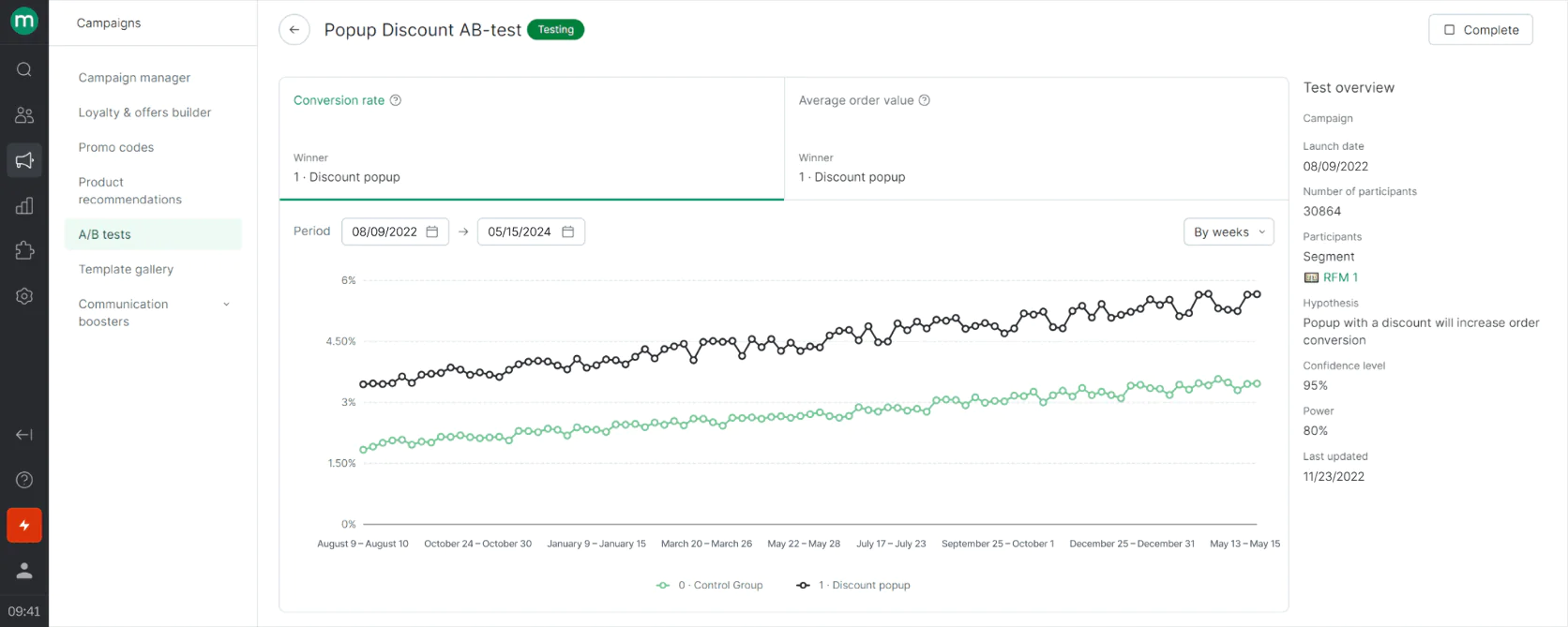
The platform provides multiple dashboards: one for loyalty program performance, one for email health, one for overall revenue vs targets, etc.

Maestra’s email health monitoring
And if you have specific metrics you want to track, Maestra’s team often helps set up some custom reports. Basically, Maestra aims to be your marketing command center where you can see everything—emails, SMS, site engagement, ads, loyalty redemption, etc.—in one place and understand how they interplay.
This comprehensive insight can help marketers tweak strategies (for example, learning that SMS drives more immediate conversions but email drives higher average order value, or that a combination of channels yields the best result). Having attribution and reporting across channels ensures you give proper credit to each touch and you can justify the spend on each part of the marketing mix.
Reporting & Attribution Winner: Maestra
Maestra takes the win because it provides cross-channel reporting and advanced attribution capabilities that neither Flodesk nor Klaviyo can fully match.
Klaviyo has excellent reporting for email/SMS in isolation and is second place here—it gives a lot of value by showing campaign ROI within its sphere. But it won’t unite your entire marketing analytics. Maestra will, and for a marketing team looking to optimize budget and strategy across every channel, that 360° visibility is invaluable.
Flodesk is basic in reporting and really only fine for small-scale needs. So, Maestra equips data-driven marketers with the richest toolkit to measure and improve their efforts across the board.
Flodesk vs Klaviyo vs Maestra: Customer Support
Flodesk
Klaviyo
Maestra
★★
Email-only, 1-day response typical
Email-only, 1-day response typical
★★★
24/7 email, live chat, CSM add-on.
24/7 email, live chat, CSM add-on.
★★★★★
Dedicated CSM + <5 min chat; proactive strategy sessions.
Dedicated CSM + <5 min chat; proactive strategy sessions.
Flodesk is a lean service and their support reflects that: it’s email-based only. The Flodesk team is known to be friendly and they often respond within a business day, which for many basic questions is okay. They also have a help center with articles and a few video tutorials.
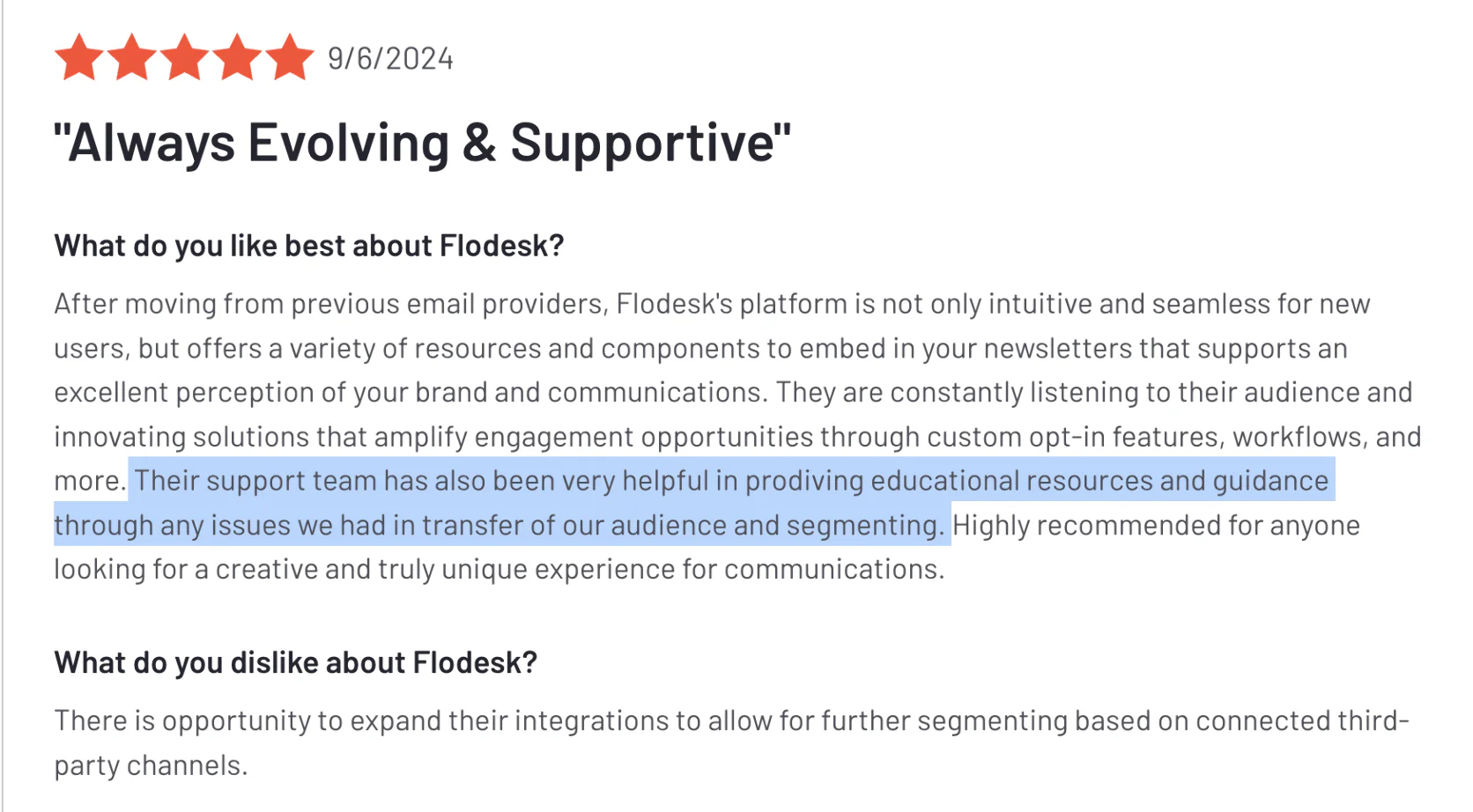
But if you run into a tricky issue or need strategic help, you might feel a bit alone. There’s no live chat for instant answers, and certainly no dedicated account managers or consultants on staff to guide you.
Given Flodesk’s target of small businesses, they likely assume users won’t demand intensive support—and indeed, many Flodesk users praise its simplicity that reduces the need for support. Still, during busy campaigns or if something isn’t working as expected, waiting for an email response can be frustrating.
Klaviyo offers more robust support channels. All paying Klaviyo customers have access to live chat support during business hours (and it may even extend longer on weekdays). There’s also email support 24/7 for urgent issues, and their response times are generally good.
Klaviyo doesn’t include one-on-one onboarding for all customers, but they do have a huge library of guides and an active community forum where Klaviyo staff and other users help solve problems. For larger customers (or those who purchase a success package), Klaviyo can provide a dedicated customer success manager or onboarding specialist, but that comes at additional cost or high plan levels.
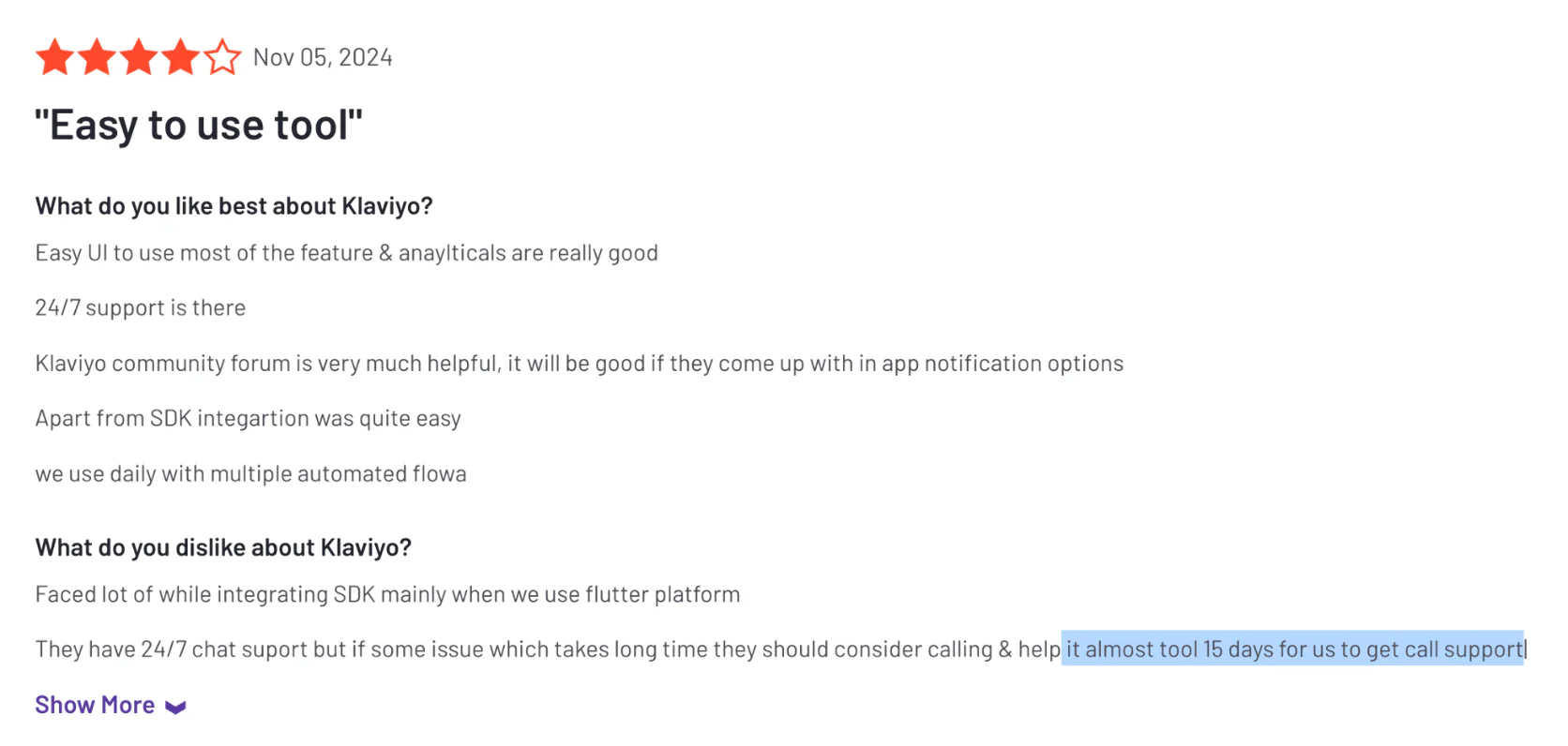
But overall, Klaviyo’s support is solid for a self-service platform, and the wealth of documentation/training available reduces how often you might need to contact them.
Maestra takes a high-touch approach. From the outset, Maestra assigns a dedicated Customer Success Manager to your account. This isn’t just a salesperson—it’s someone who will know your business goals and help you use Maestra to achieve them.
They often help plan your implementation, migrate data from previous tools, set up initial campaigns, and train your team. And this isn’t reserved for only the highest plan—it’s standard for Maestra clients.
Additionally, Maestra offers extremely responsive chat support; their team often replies in minutes (typically under 5 minutes).
Because Maestra positions itself as an all-in-one for midmarket, they know many clients are transitioning from a patchwork of tools and might need guidance rethinking their strategy. The support team is there to consult on best practices, not just break-fix issues. Weekly or monthly check-in calls are common, where they review performance, suggest optimizations, or introduce new features.
Essentially, Maestra’s support feels more like an extension of your marketing team—you get white-glove service that’s proactive, not just reactive.
Customer Support Winner: Maestra
Maestra clearly leads on support by including one-on-one, high-touch assistance as a core part of its offering. Marketing teams using Maestra won’t feel like they have to figure everything out solo—they have experts on call.
Klaviyo has very good support for a scalable software company, especially with chat and extensive self-serve resources, so it earns second place. Many Klaviyo users are happy with the support, but if you want someone to actually help plan your campaigns, that’s outside their normal scope (unless you pay for consulting).
Flodesk’s support is adequate for simple needs but can’t compare to the other two.
In summary, Maestra treats support as part of the product value, making it the top choice if guidance and quick help are important to you.
Flodesk vs Klaviyo vs Maestra: Integration Capabilities
Flodesk
Klaviyo
Maestra
Requires connectors and developers’ help.
Hundreds of pre‑built integrations.
Pre‑built integrations and assistance in building custom connectors.
Flodesk is relatively limited in integrations. It provides native integrations with a few popular apps, but the list is small. Flodesk mainly encourages using Zapier or similar middleware to connect to other tools. That works, but it can be clunky and might have delays or require technical effort to set up correctly.
There’s also an API for developers to build direct integrations, but that’s beyond the reach of most non-technical users.
If your marketing stack is very simple, Flodesk’s lack of integrations isn’t painful. But as soon as you want Flodesk to play nicely in a larger ecosystem (like syncing with a customer support platform or pulling data from a loyalty app), you’ll hit a wall without custom solutions.
Thus, Flodesk’s integrations are basic—sufficient for a simple website and email collection, but not much more.
Klaviyo shines in integrations. It has pre-built, one-click or easy setup integrations with hundreds of services—from e-commerce platforms (Shopify, Magento, WooCommerce, BigCommerce, etc.) to CRM systems, review apps, help desks, subscription apps, you name it. If an app is commonly used by e-commerce or DTC businesses, chances are Klaviyo has an integration or it’s on their tech partner list.
These integrations typically allow Klaviyo to import events and data (like orders, product catalog, subscription status) and sometimes export data (like pushing back email engagement data to a CRM). For marketers, this means you can unify a lot of customer info in Klaviyo without heavy lifting.
The ecosystem around Klaviyo is also huge—many third-party tools build Klaviyo integrations from their side. Klaviyo’s open API also allows any custom integration you might need; many brands use it to do bespoke things if necessary.
So, Klaviyo acts as a central hub in the stack, second only to perhaps the e-commerce platform itself. The benefit is clear: your emails and texts can be enriched by data from all over (past bookings, support tickets, etc.) and you can incorporate Klaviyo into various workflows (like triggering a Slack alert to your team via Zapier if a VIP customer has a complaint—because Klaviyo knows who VIPs are, for example).
Simply put, Klaviyo’s integration capabilities are excellent, making it adaptable to almost any environment.
Maestra also integrates with a variety of platforms, especially those relevant to retail and e-commerce. It supports direct integrations with popular e-commerce systems (to pull in orders, products, customer info), and has connectors for things like ad platforms, analytics tools, and legacy CRM or ESP systems for migration.
The difference is that Maestra offers custom integration support. That means if you have an in-house system or a niche tool, Maestra’s team can help build the connection (especially since every client has a dedicated success manager who can liaise with their developers).
Maestra also has a comprehensive API, so technically anything is possible integration-wise. The idea is that Maestra wants to be your single source of marketing truth, so they’re quite flexible in bringing data in or pushing data out to other systems. For instance, if you use an ERP or a data warehouse, Maestra can integrate so that data flows seamlessly. And because it’s aimed at midmarket/enterprise, they anticipate more custom setups and thus handle those case by case if needed.
In practice, a Maestra user can integrate with major review platforms, loyalty systems (though Maestra has its own, you might have legacy data), multiple e-commerce storefronts if you run several, etc., either through existing connectors or with some assistance setting it up.
The bottom line is, Maestra will integrate with essentially anything important, either natively or via its API/white-glove approach.
Integration Capabilities Winner: Tie—Klaviyo and Maestra
Klaviyo and Maestra both score top marks for integration, but in slightly different ways.
Klaviyo has the edge in sheer number of out-of-the-box integrations and a massive community of tech partners. If you’re using common SaaS tools, Klaviyo likely just works with them with minimal fuss.
Maestra matches this for all major needs and excels in custom integrations, effectively saying “if we don’t have it, we’ll help you build it”. For a marketing team that has unique systems or wants more hands-on support connecting the dots, Maestra’s approach is extremely valuable. In terms of capability, Maestra can integrate just as deeply (if not more so, given it covers more channels)—so it’s not lacking.
Given this, we’ll call it a tie: Klaviyo for broad plug-and-play integration strength, Maestra for guaranteed integration flexibility plus assistance.
Flodesk is far behind here, suitable only if you have a very simple stack or are okay using Zapier for most things.
Flodesk vs Klaviyo vs Maestra: Educational Resources
Flodesk
Klaviyo
Maestra
★★★★
Flodesk University, blog and help center.
Flodesk University, blog and help center.
★★★★★
Klaviyo Academy, blog and help center, community forum, live webinars.
Klaviyo Academy, blog and help center, community forum, live webinars.
★★★★★
One-on-one sessions with a dedicated CSM, blog and help center.
One-on-one sessions with a dedicated CSM, blog and help center.
Flodesk, despite being a smaller product, has invested in user education for its niche. They created Flodesk University, which is a series of free video courses (generally quick, under 10 minutes each) on topics ranging from getting started with Flodesk to general email marketing tips. This is great for beginners who might not be email marketing experts—it’s like getting a mini training on best practices while learning the tool.
Flodesk also has a blog that covers basic strategies, and they sometimes host webinars or collaborations (often with influencers or power users demonstrating how they use Flodesk).
The Flodesk Help Center contains step-by-step guides for using features, which is pretty standard but well-written.
The resources are friendly and approachable, in line with their brand.
Klaviyo offers an extensive array of educational content. There’s Klaviyo Academy which houses on-demand courses and even certifications (you can become “Klaviyo Product Certified” for instance). They cover everything from basic account setup to advanced segmentation tactics in these courses.
Klaviyo regularly runs live webinars on various topics (holiday marketing prep, segmentation deep dives, etc.) and also has an annual conference where lots of strategy sessions happen. The community forum is almost an educational resource itself—many Q&As are publicly viewable, so you can learn from other users’ scenarios. Moreover, because Klaviyo is widely used, third-party agencies and experts produce tons of content: YouTube tutorials, blog posts (“10 Klaviyo flow ideas” kind of articles), and podcasts.
Klaviyo’s own documentation is very thorough, and they also provide help texts and tips throughout the UI. One notable offering is their benchmark reports—using aggregate data to educate customers on what good performance looks like in their industry. Basically, if you want to become a better e-commerce marketer, Klaviyo’s ecosystem gives you ample opportunity to learn not just the tool but also strategy. This is a big plus for marketing teams that want to upskill or onboard new team members quickly.
Maestra’s educational resources include its knowledge base, which covers how to use features (and given the platform’s breadth, there’s a lot to cover). They also publish articles on their blog about marketing strategies.
They may not have a massive free academy like Klaviyo yet (simply due to being newer), but they effectively educate their clients through the white-glove support model. When you have weekly calls with your Customer Success Manager, you’re getting tailored education for your business. They’ll advise on strategies, teach you how to interpret the reports, and even train new team members on using Maestra. It’s a different style of education: more personalized and less publicly visible.
Educational Resources Winner: Tie—Klaviyo and Maestra
Klaviyo offers vast and well-structured content for users at all levels. The combination of Klaviyo Academy, extensive documentation, community knowledge, and third-party content means a motivated marketer can become a Klaviyo power user (and a better email marketer in general) relatively easily.
Maestra has a different approach—instead of generic courses, it offers hands-on, customized education through its support team and focused content. This is incredibly valuable for clients.
Flodesk is commendable for providing Flodesk University and keeping things simple for novices, but it doesn’t match the depth the other two offer for more advanced learning.
Flodesk vs Klaviyo vs Maestra: Pricing
Flodesk
Klaviyo
Maestra
Flat $38/mo unlimited email—great for starters.
Free up to 250 contacts; scales steeply with list size/SMS.
Custom all-in-one fee; replaces multiple tools, support included.
Flodesk’s pricing is simple and affordable—one of its big selling points. It has two plans: one for Email only at $38/month, and one that includes Email + Checkout features at $64/month (these are flat rates with unlimited contacts and sends).
This flat pricing model is almost unheard of in email marketing, as most competitors charge more as your list grows. For a small business with, say, 50k subscribers, paying $38/month where Mailchimp or others might charge hundreds, Flodesk is a bargain.
However, keep in mind why it’s able to be flat and low: Flodesk’s feature set is limited. If you outgrow those features, you’ll start paying for other tools (which effectively adds to your marketing stack cost). There’s no tier with more support or anything; everyone gets the same.
Overall, if your main criterion is low cost and you only need basic email, Flodesk is almost unbeatable on price/value. If you factor in needing additional tools (like an SMS service, a loyalty app, etc.), the total cost of ownership goes up accordingly.
Klaviyo’s pricing follows the typical SaaS model for email: you pay based on the number of contacts (and the number of SMS messages if you use SMS). It does have a small free plan (up to 250 contacts and 500 emails, currently) which is nice for trying it out.
But once you grow: for example, at 10,000 contacts, Klaviyo’s email plan is around $150/month. At 100,000 contacts, it’s roughly $700-1200/month depending on email volume.
If you add SMS, that’s extra; Klaviyo might charge e.g. ~$0.01 per text, or offer packages. They also introduced an add-on CDP component for very large customers that costs extra, but most mid-sized brands get what they need in the base price.
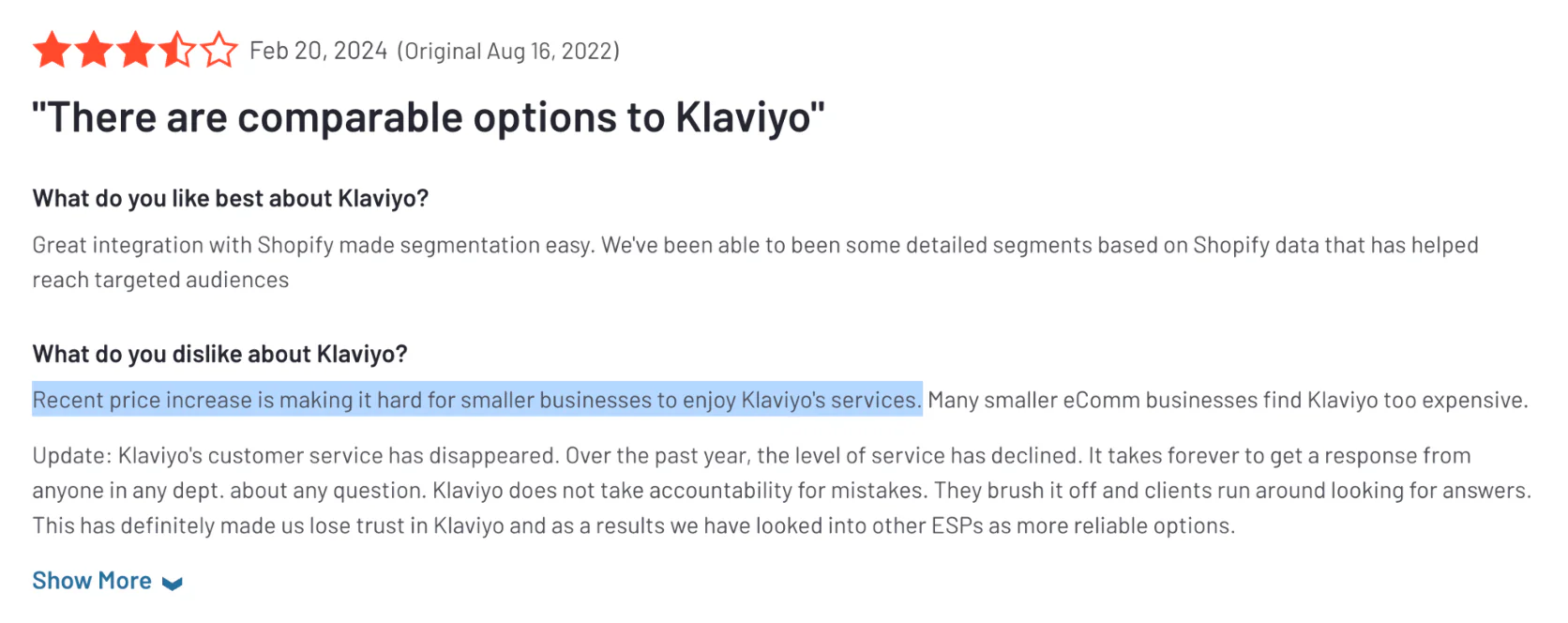
Klaviyo can become one of your bigger SaaS expenses as you scale, which some criticize, especially after some price increases. That said, many find it “worth it” because the revenue you can drive with Klaviyo often far exceeds its cost (the ROI is high if used well).
The pricing is month-to-month, no long contract needed (though annual plans can save a bit). One positive is all features are included at all tiers—you don’t pay more for premium features, you just pay for size/usage. Support is also included (except for optional high-end support packages).
So Klaviyo’s pricing is fair for the market but can grow expensive as your audience grows, which is something to budget for. Often by the time it gets costly, your business is also larger and can justify it, but it’s definitely a different universe from Flodesk’s flat $38.
Maestra uses a profile-based pricing model with tiers.
All Maestra packages include the full platform capabilities—they’re not going to upcharge you for adding one more feature module—and they all include the dedicated support/service as well.
The pricing can start higher than Klaviyo’s. However, Maestra positions its value as replacing multiple tools and possibly headcount. If you currently pay for an email platform, an SMS platform, a personalization platform, a loyalty platform, and maybe a CDP—once you consolidate into Maestra, you drop those other fees. In many cases, that combined cost could be equal or more than Maestra’s cost.
The scalability is there: Maestra can handle very large databases and send volumes, so it’s priced for serious operations.
It’s also worth noting the white-glove support is included, which if you valued as a service, could be quite expensive on its own from consultants—but Maestra wraps it in.
Overall, expect Maestra to be an investment, on par with enterprise marketing software, but also consider the ROI and savings from potential increased revenue and tool consolidation. They also offer flexibility like cancel-anytime, so you’re not locked into paying for capacity you don’t use.
Pricing Winner: Maestra (Value at Scale)
This might seem counter-intuitive since Maestra is the most expensive up-front, but we’re looking at overall value and scalability for marketing teams.
Maestra wins on pricing in the sense that as you layer on what you’d need to match its capabilities (multiple tools, extra services), competitors can end up costing more in sum.
Maestra’s all-in-one pricing brings predictability and often lower total cost for mid-sized businesses that would otherwise pay for 5-6 different platforms (and possibly waste time integrating them).
Also, every Maestra plan includes top-tier support and features, so you’re not faced with hidden costs as you utilize more features.
Flodesk is clearly the cheapest for small-scale needs, and perfect if budget is king and needs are basic—but it’s not a solution that scales well into a comprehensive marketing system without lots of add-ons (so its price is low, but its capabilities per dollar drop off when you need more).
Klaviyo strikes a middle ground: reasonable and pay-as-you-grow for what it offers, but if you fully leverage it and have a large database, you will be investing a substantial amount monthly.
Many growing brands start with Klaviyo for its immediate ROI and then later evaluate switching to something like Maestra when they approach a point where they need more channels or find Klaviyo’s cost climbing along with needing other add-ons.
In conclusion, for a marketing team with serious growth ambitions and the need for a broad feature set, Maestra provides the best value as a unified platform—whereas Flodesk is best for shoestring budgets and Klaviyo is best for a balance of power and cost in the SMB to lower-midmarket stage.
Final Thoughts
Choosing between Flodesk, Klaviyo, and Maestra ultimately comes down to the scope and ambition of your marketing efforts:
Flodesk
Flodesk is ideal for early-stage businesses, creators, or boutiques that prioritize design and simplicity over advanced functionality. Its flat pricing and easy-to-use email builder are attractive if you just need to send great-looking emails and aren’t ready to dive into complex marketing tactics. However, as a marketing team grows, Flodesk’s limitations (no multi-channel, no deep data, no built-in growth tools) will become apparent. It’s a fantastic “starter” tool for email-centric marketing on a budget, but you’ll likely graduate from it once you require more than just basic email newsletters.
Klaviyo
Klaviyo represents the next level up—it’s the proven workhorse for e-commerce marketing teams. If you need powerful email and SMS automation, rich customer segmentation, and seamless integration with your online store, Klaviyo delivers. Marketing teams using Klaviyo can execute sophisticated campaigns and see clear revenue results, which is why it’s beloved in the e-commerce community. The trade-off is cost and complexity: Klaviyo isn’t as cheap or simple as Flodesk (especially as your contact list grows), and it still leaves gaps (no loyalty program, limited on-site personalization) that you might fill with other apps.
In essence, Klaviyo is great for retention marketing via email/SMS, and it can stretch to some omnichannel via integrations. It’s a solid choice for mid-sized brands growing their customer base who want a robust, familiar platform with a huge ecosystem.
Maestra
Maestra is geared towards companies that are ready to unify and elevate their entire marketing strategy. If your team is managing multiple disparate tools and struggling to keep customer experiences consistent, Maestra comes in as the all-in-one solution. It shines for midmarket and enterprise brands that want to leverage advanced tactics—real-time personalization, AI-driven localization (speaking to each customer in their own language automatically), and even voice-to-voice content adaptations—all while maintaining a single source of truth for customer data. Maestra’s strength is in breaking down silos: your email, SMS, site, app, ads, loyalty, etc., all work in concert, informed by the same data. This not only boosts marketing effectiveness (higher engagement, conversion, retention) but can also reduce overhead and errors from juggling many platforms. Plus, the included hands-on support means even a lean marketing team can punch above its weight, implementing sophisticated campaigns that would normally require multiple specialists. The investment in Maestra is higher, but so is the return—many brands find that it pays for itself by driving more revenue and consolidating tech spend.
Final recommendation
- If you’re a small operation with straightforward needs, Flodesk will serve you well until you’re ready to expand your marketing playbook.
- If you’re a growing brand focused on e-commerce retention and you need a reliable, powerful platform today, Klaviyo is a safe and effective bet—it’s the industry standard for a reason, covering email/SMS automation and analytics in depth.
- If you find yourself dreaming bigger—orchestrating truly personalized customer journeys across every channel, and maximizing engagement at each touchpoint—Maestra is the platform built to achieve that vision.
Each of these tools can get you to your next destination, but if your goal is to cover the most ground and reach new heights with your marketing—especially as you scale—Maestra is equipped to take you there the fastest and with the most control. It empowers marketing teams to not just run campaigns, but to create experiences that resonate with customers on a personal level, across all channels, driving growth and loyalty in ways the other tools cannot match.
Ready to boost your marketing? Book a demo with Maestra team now
